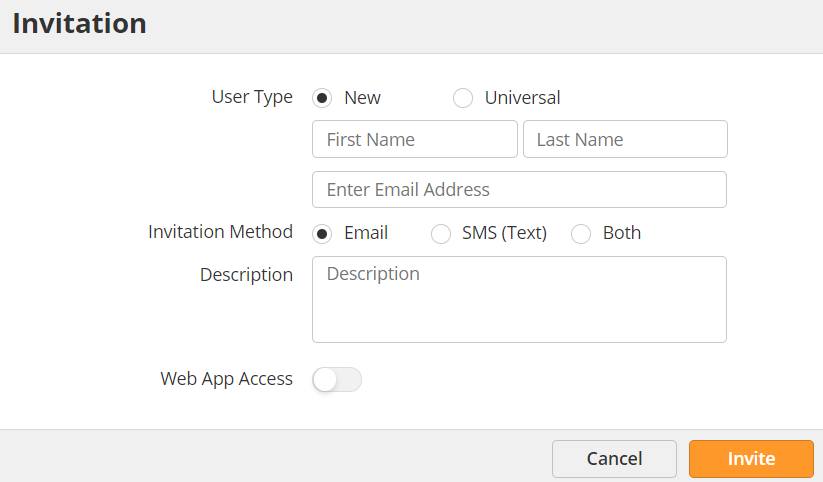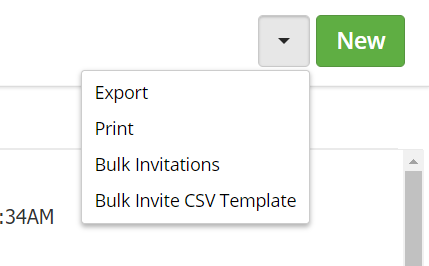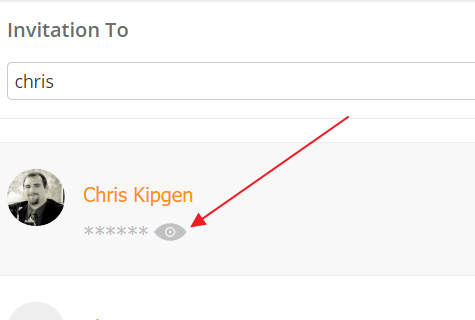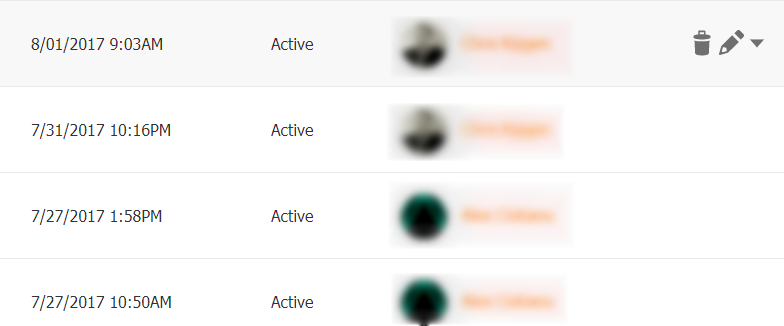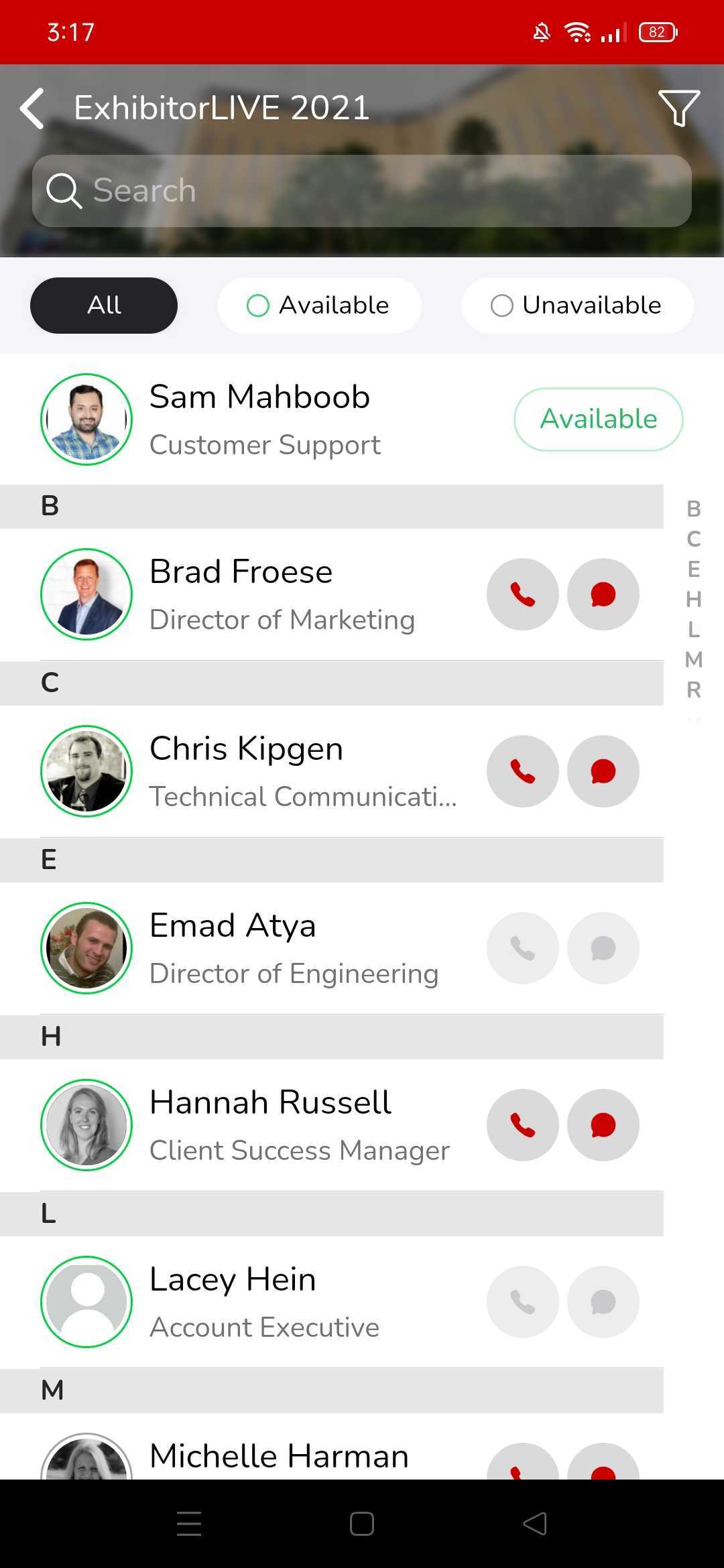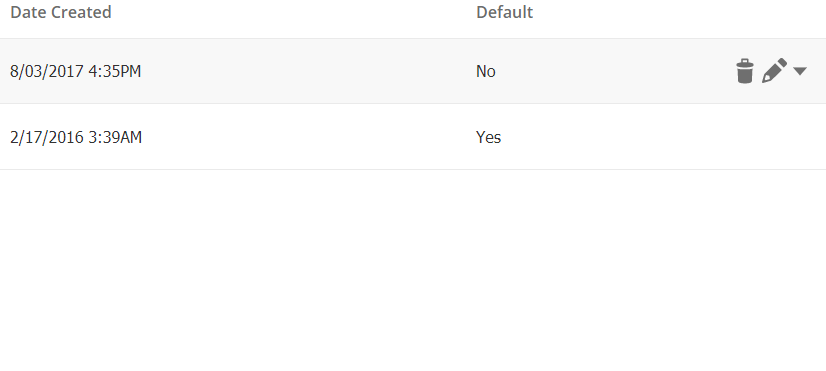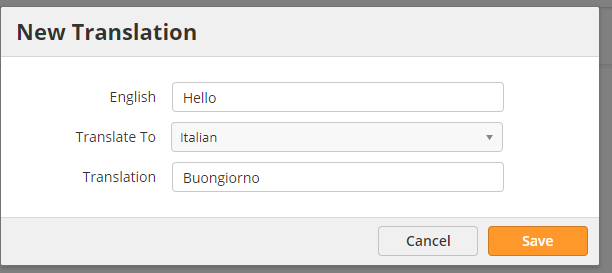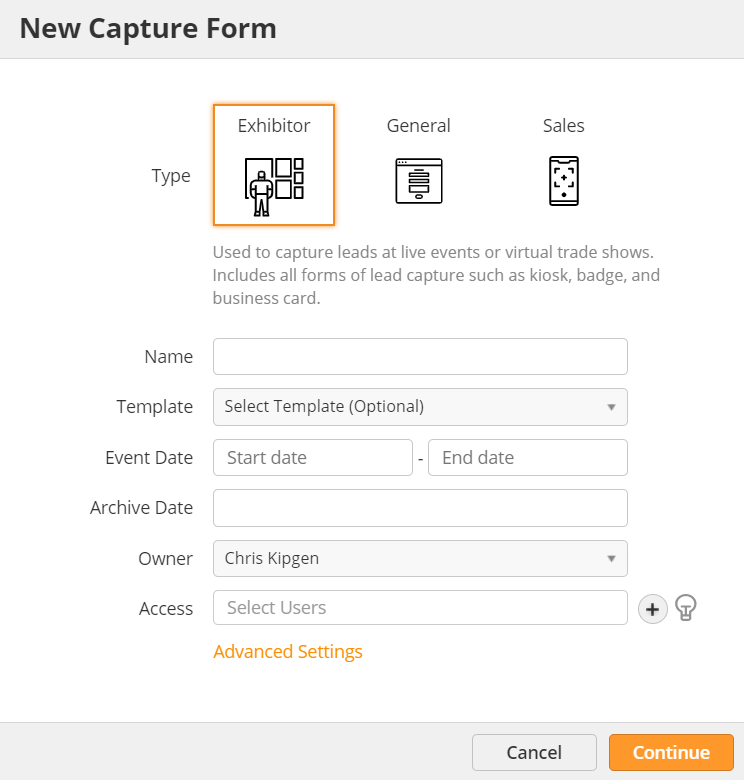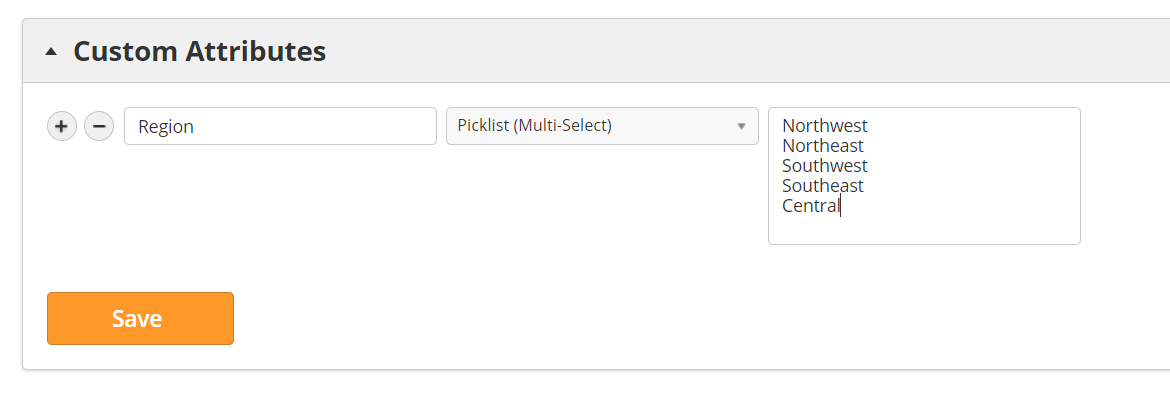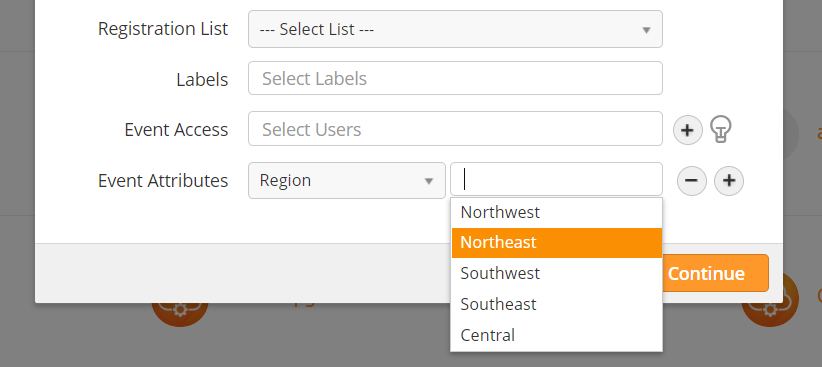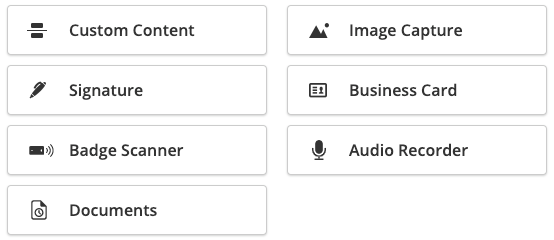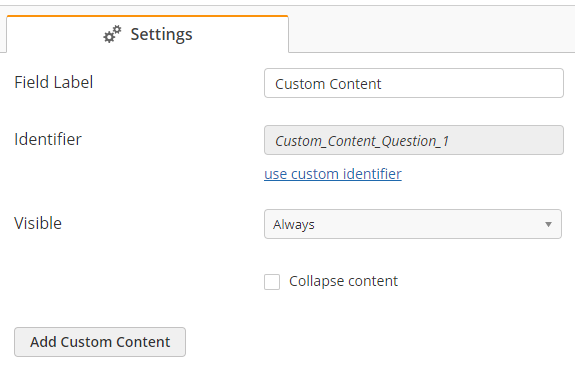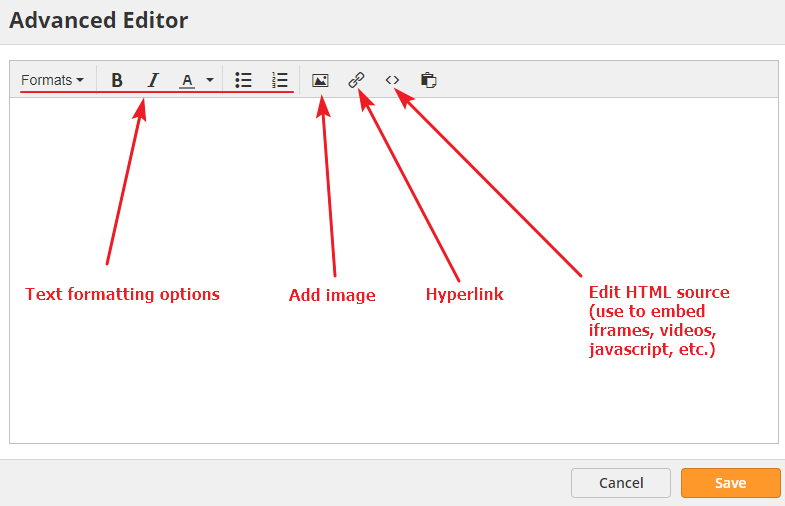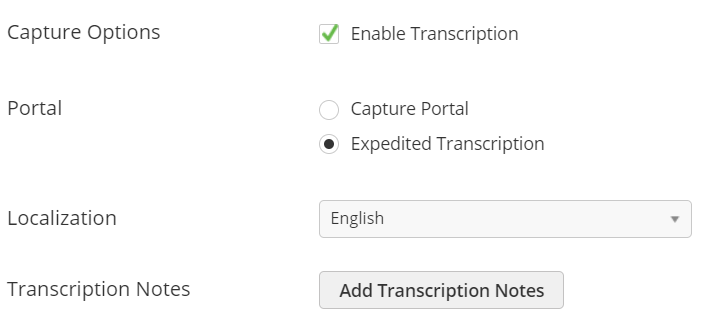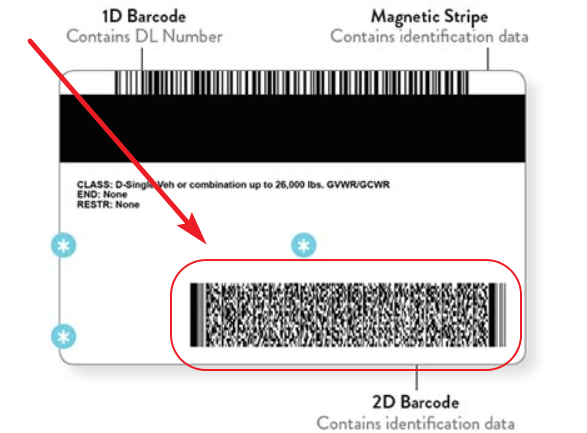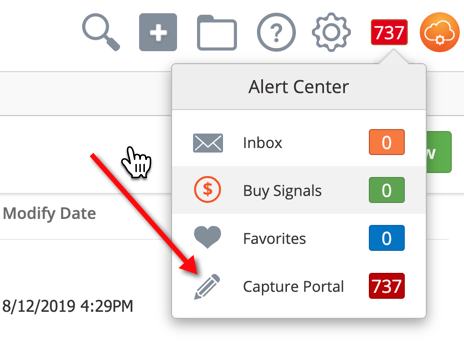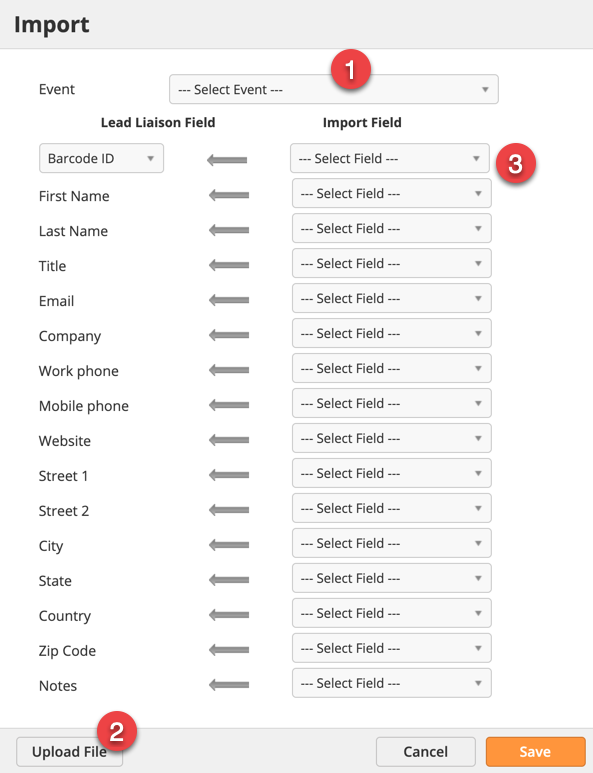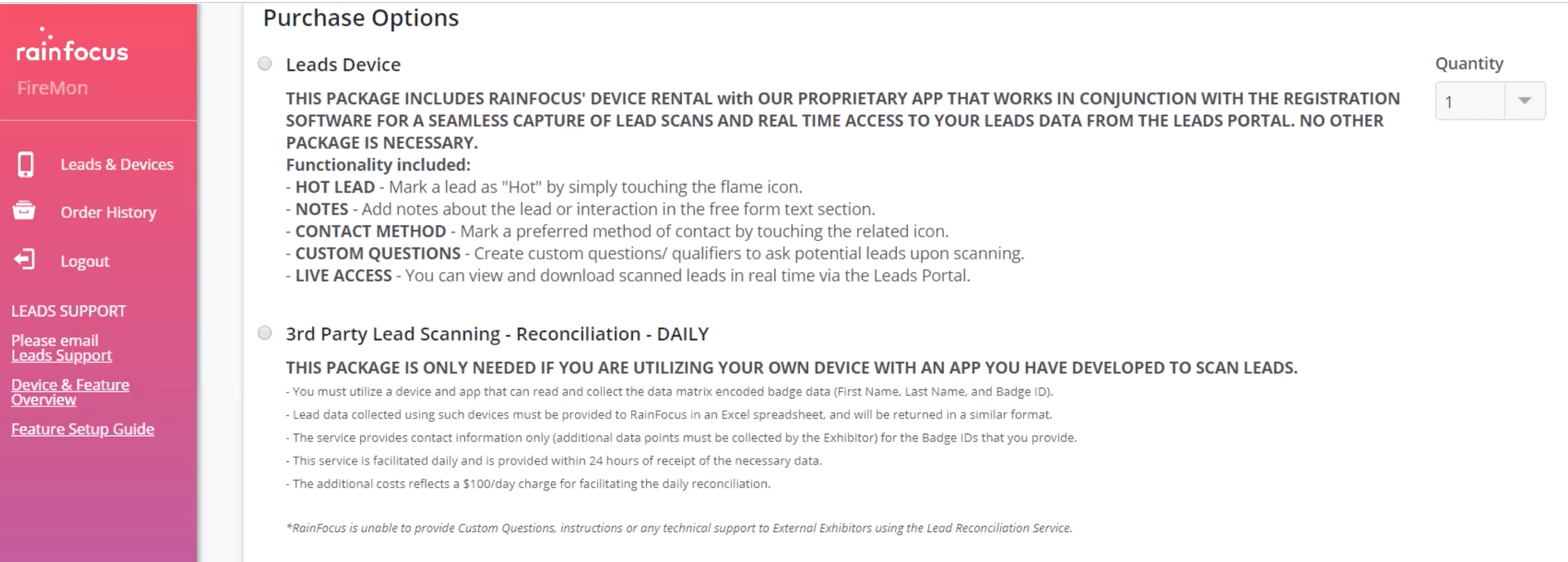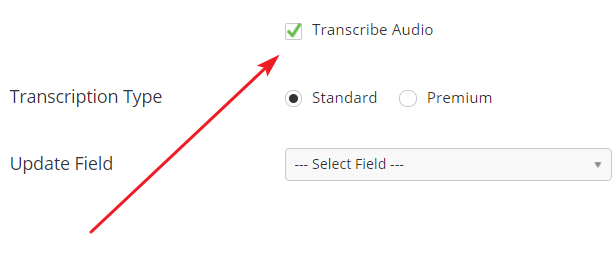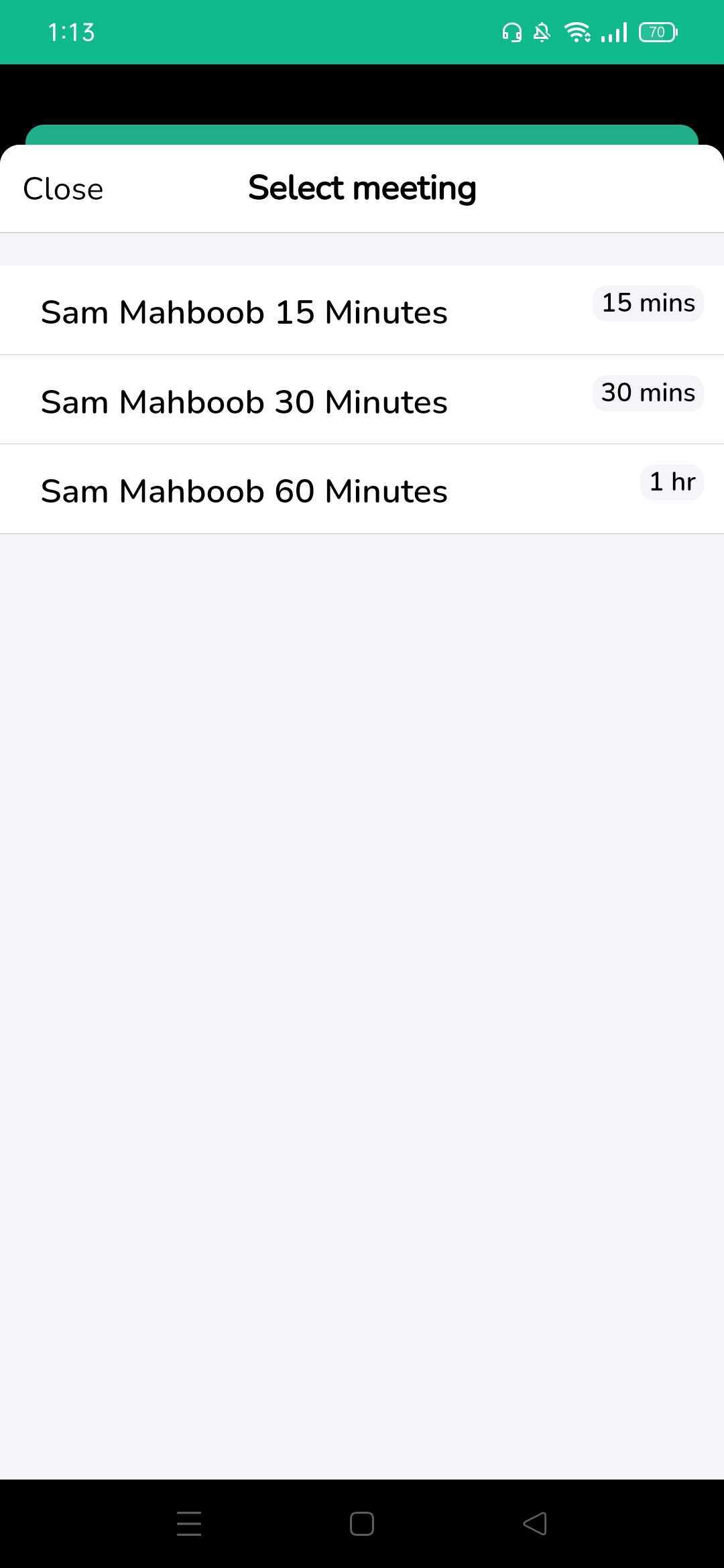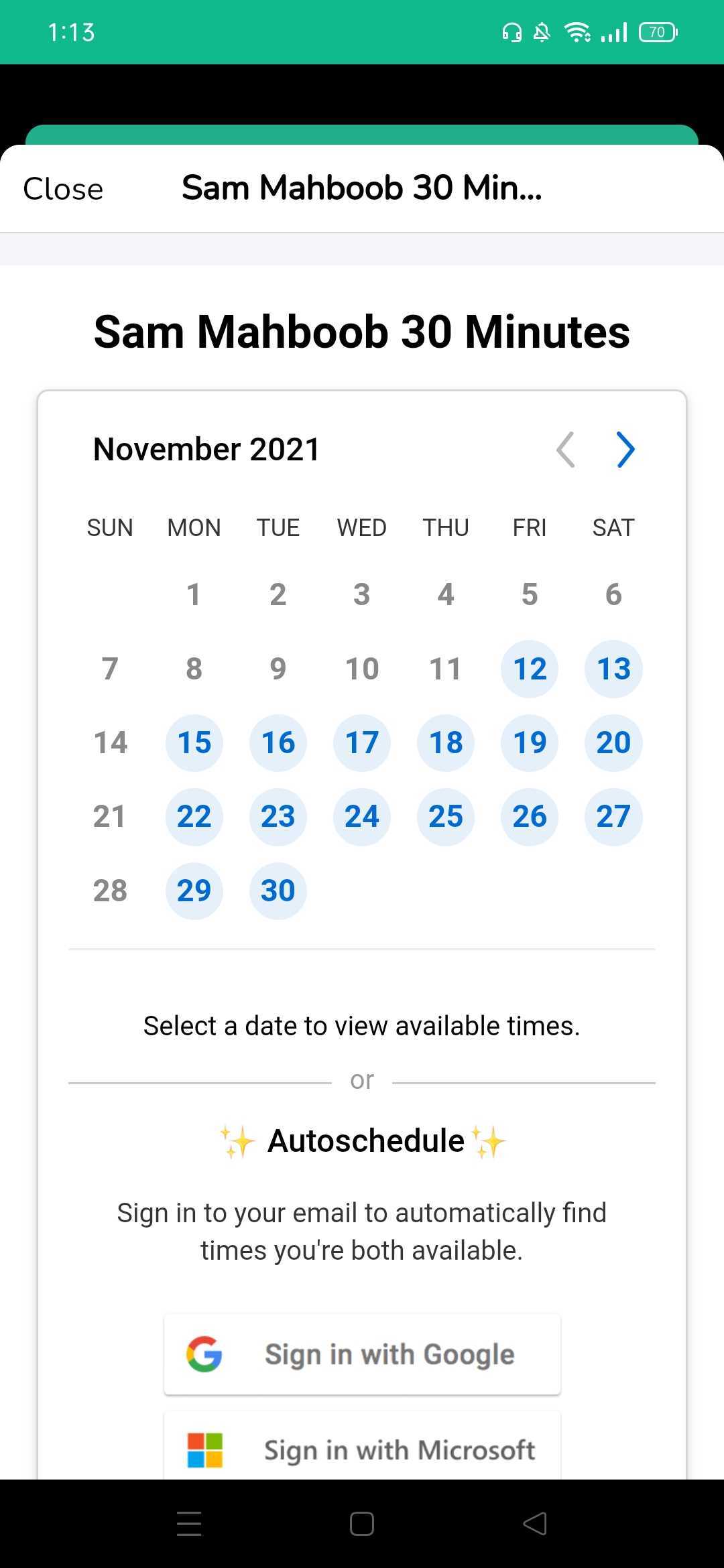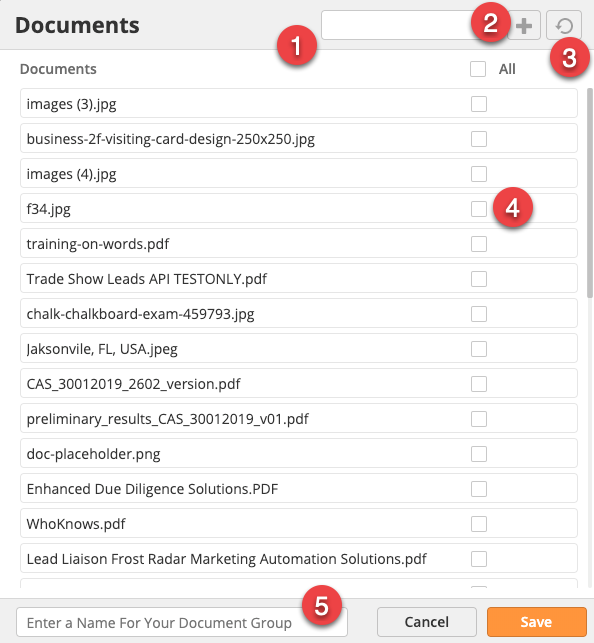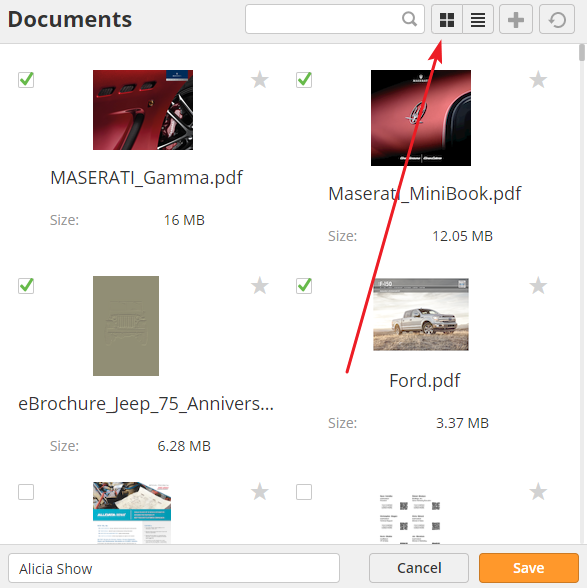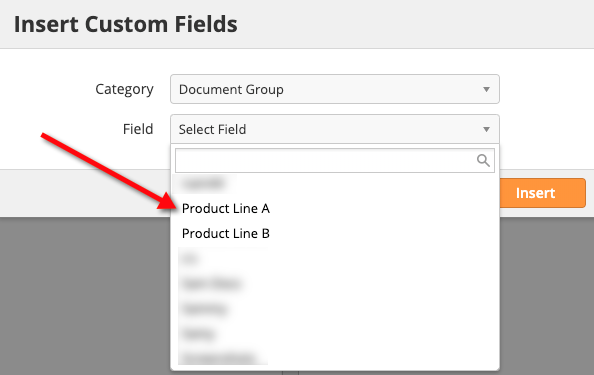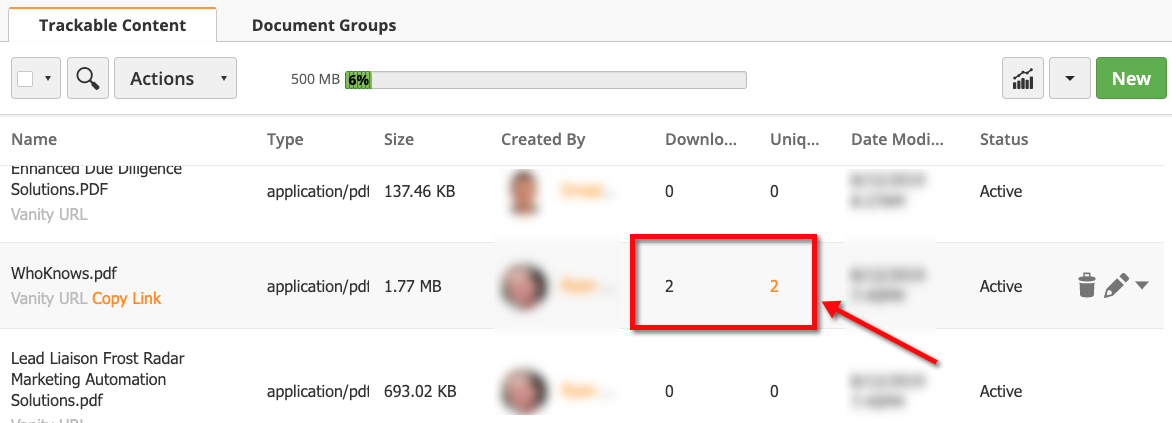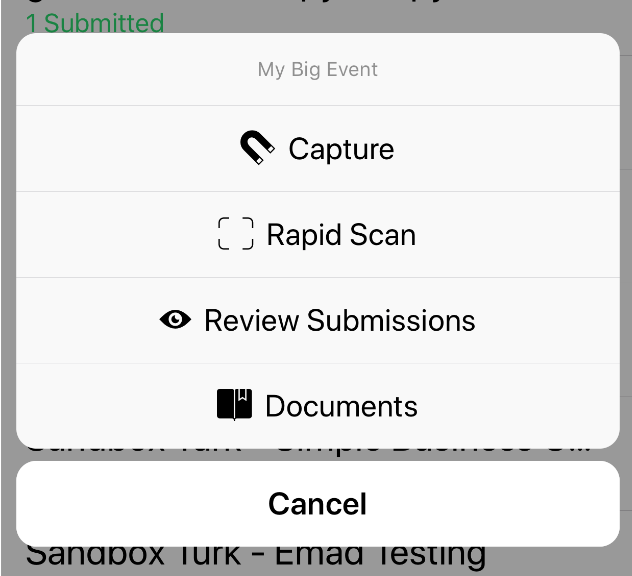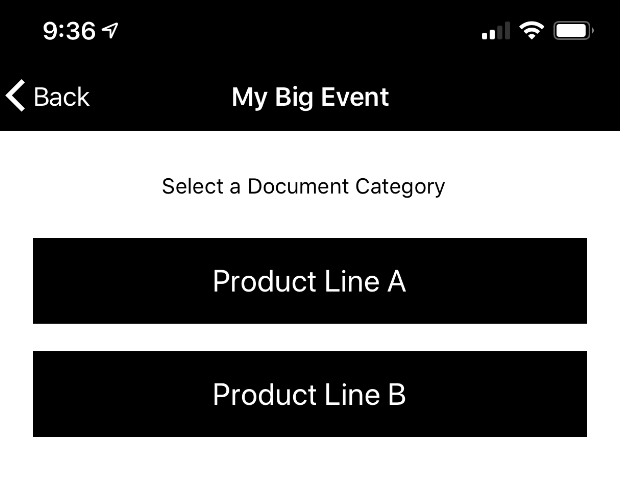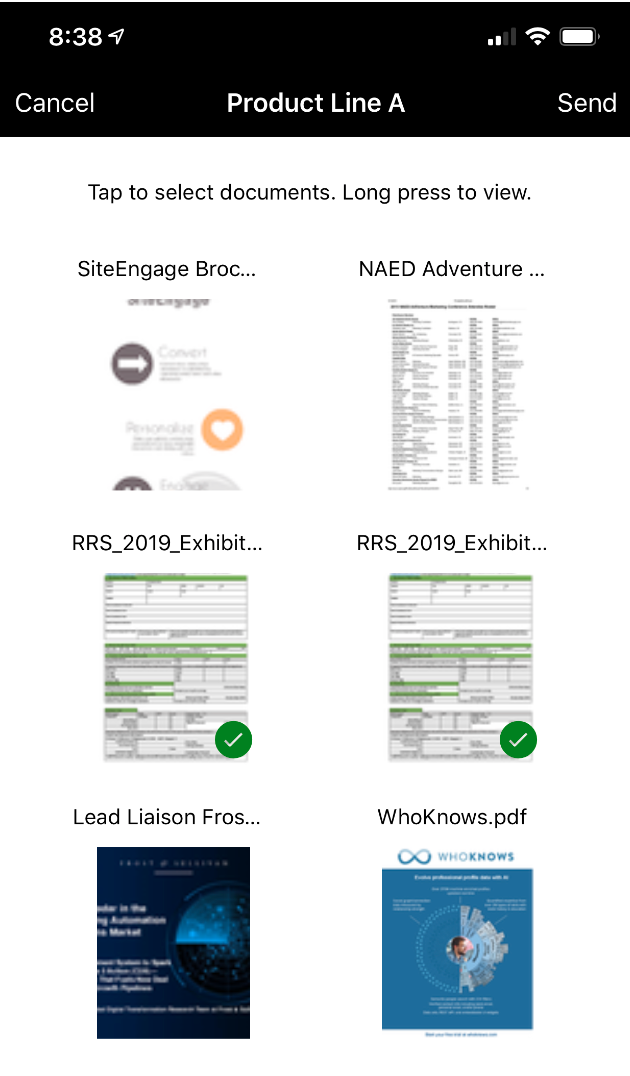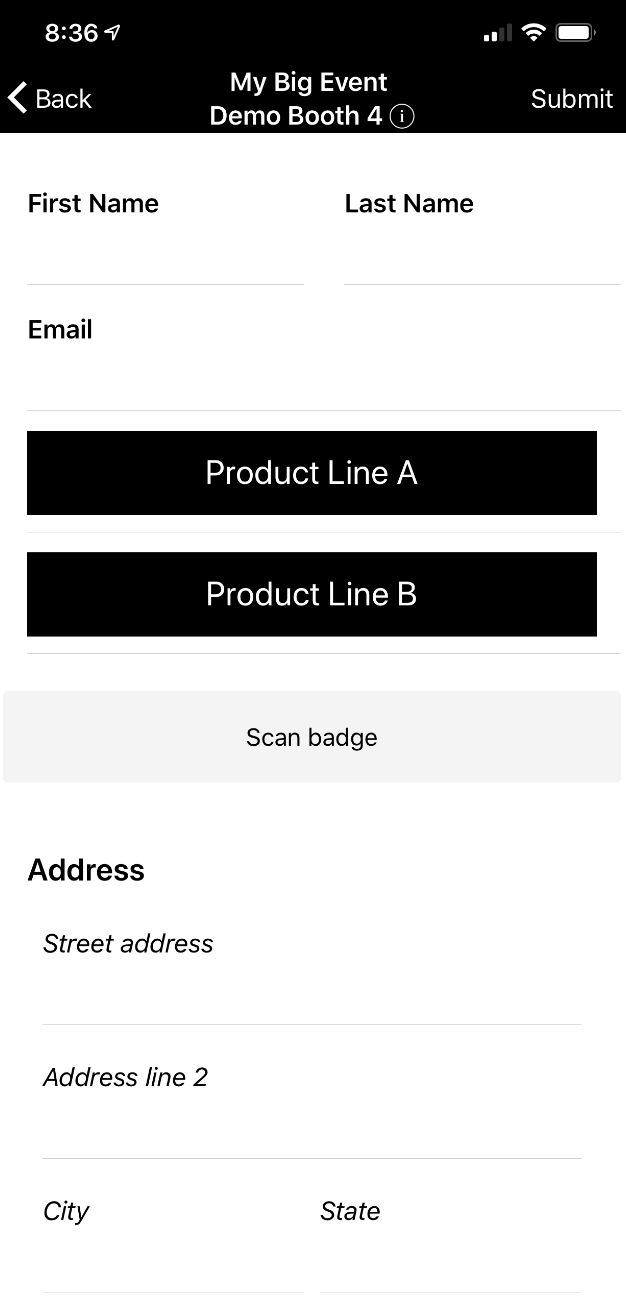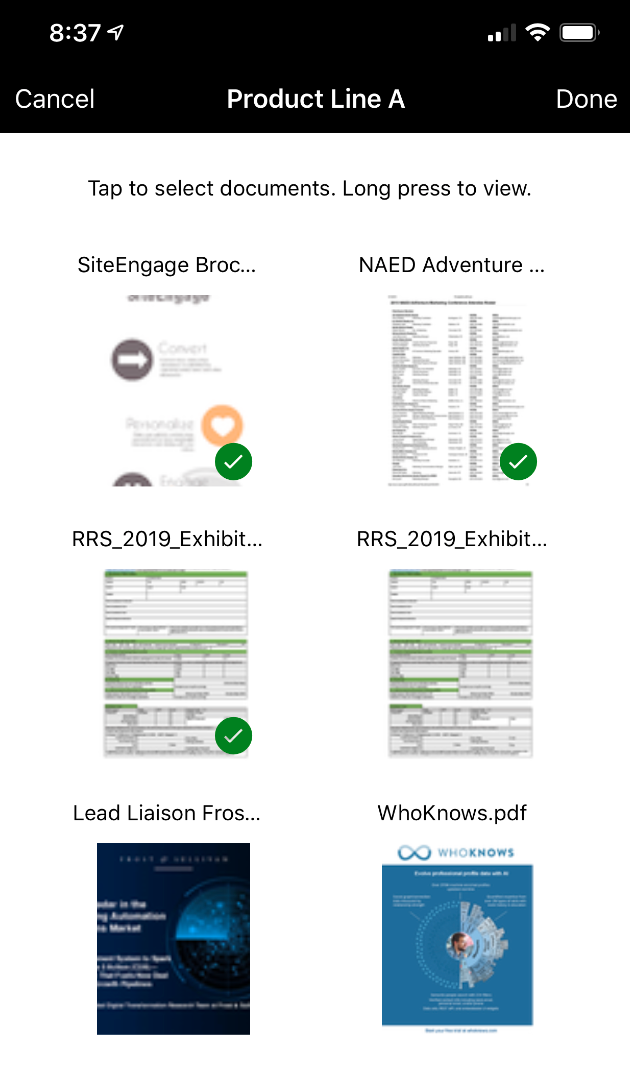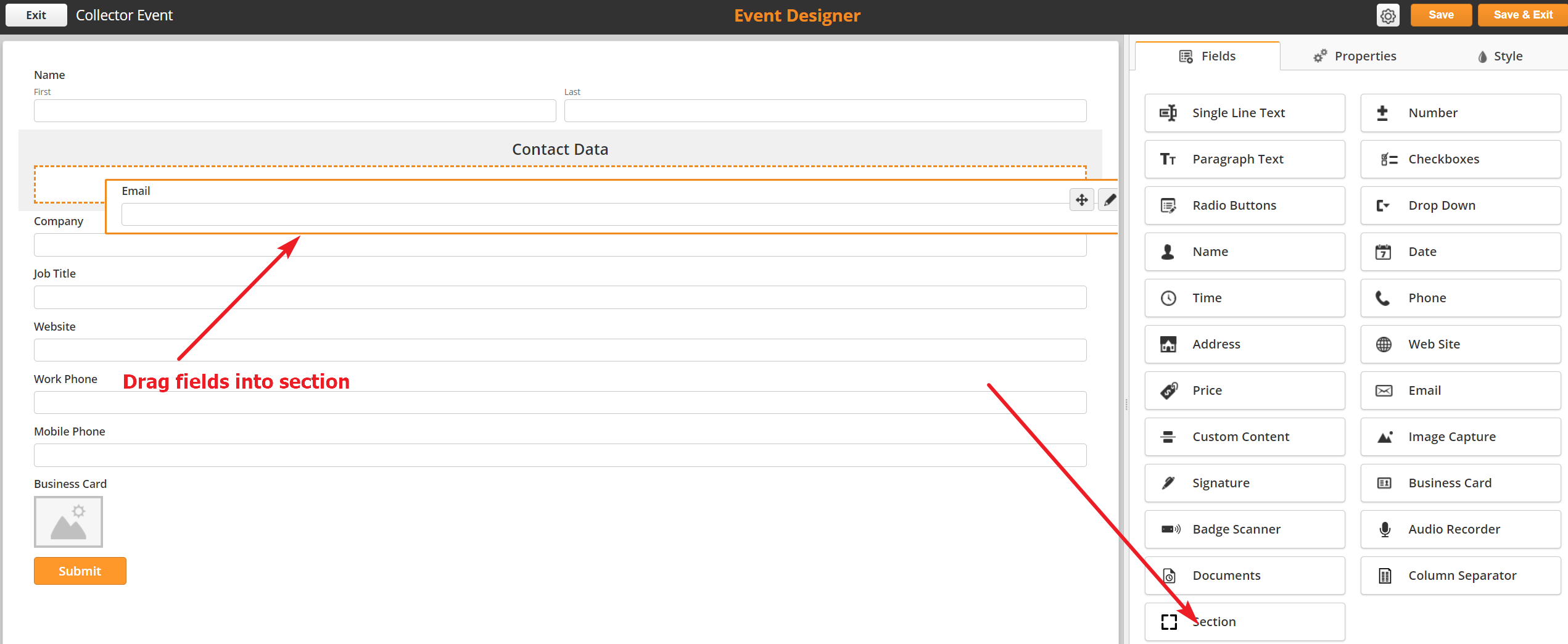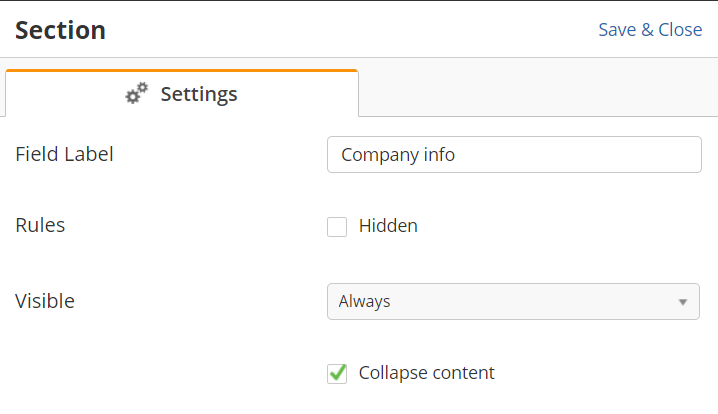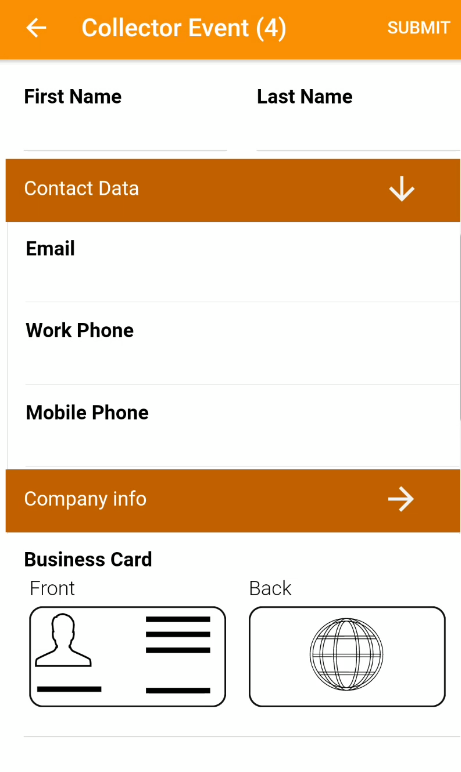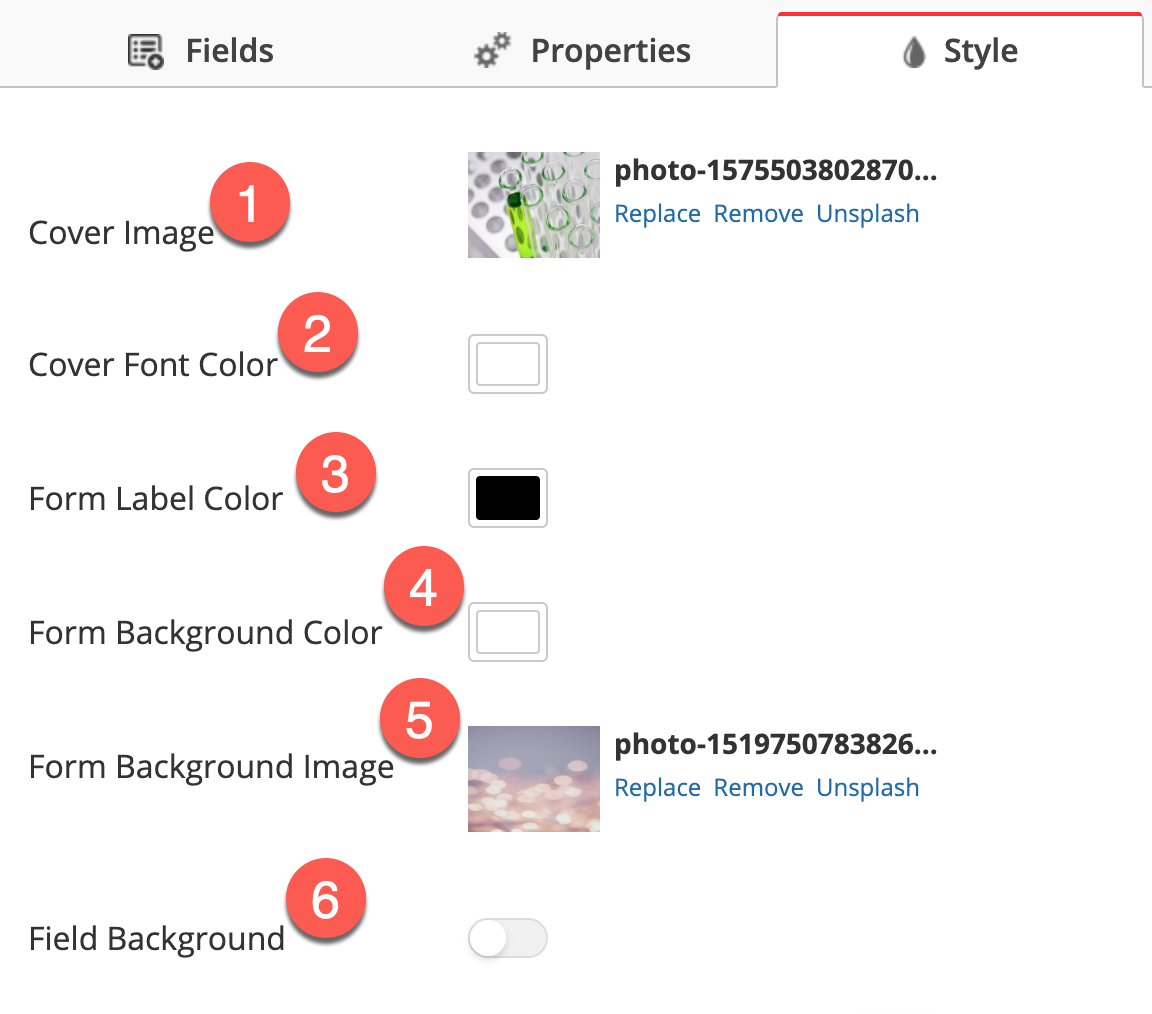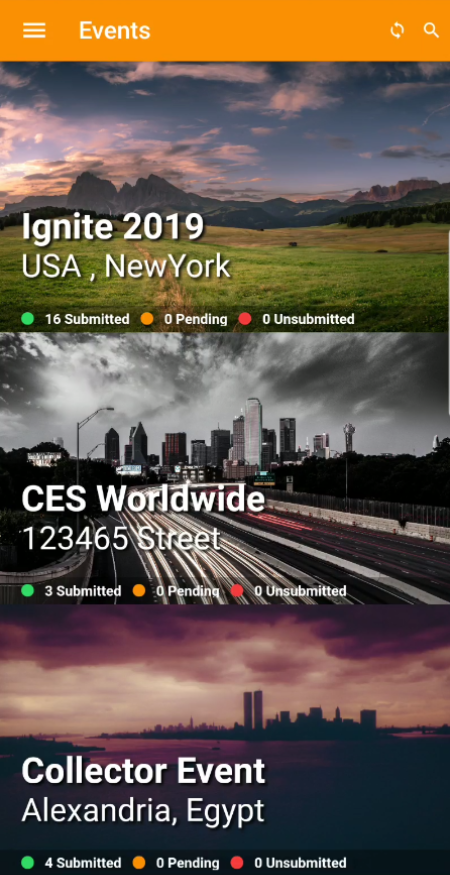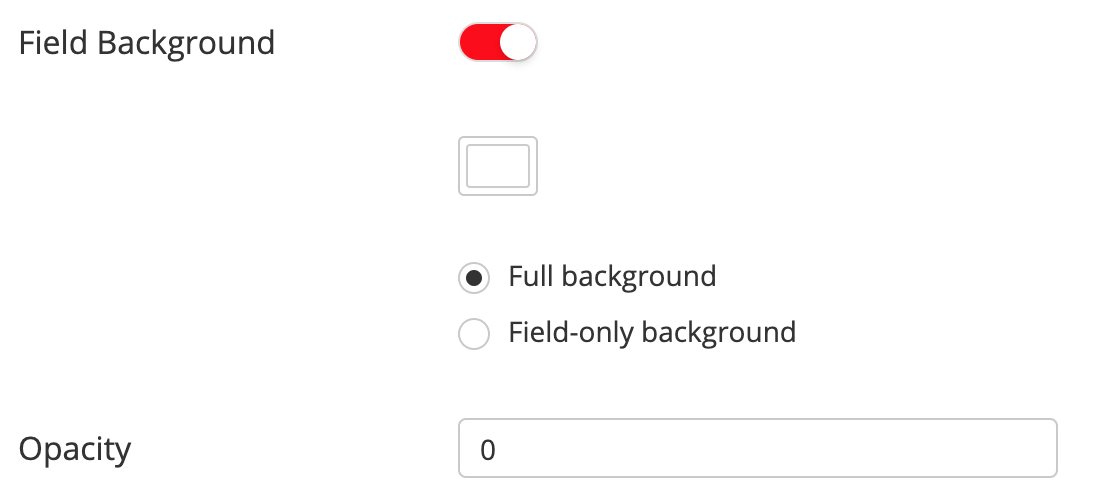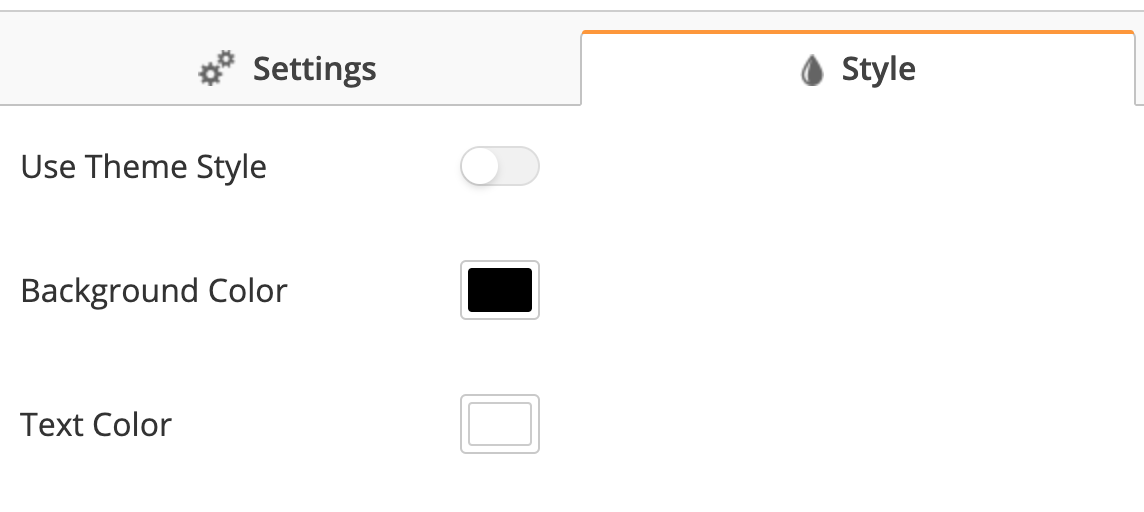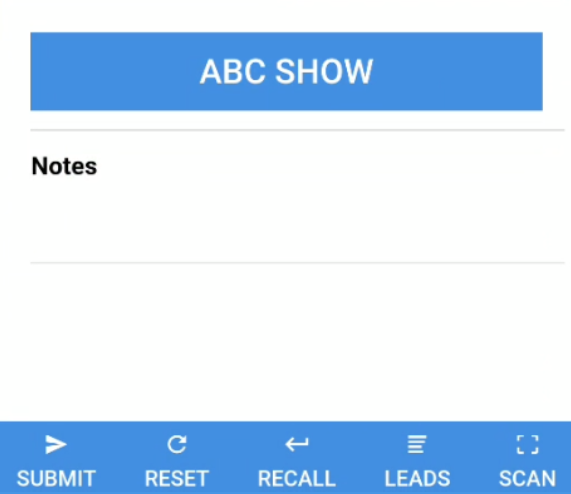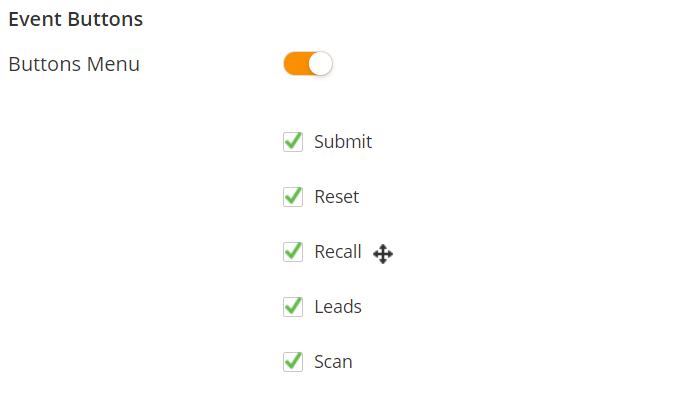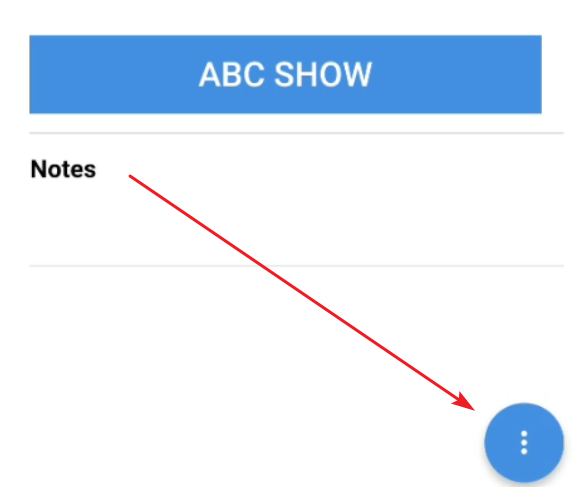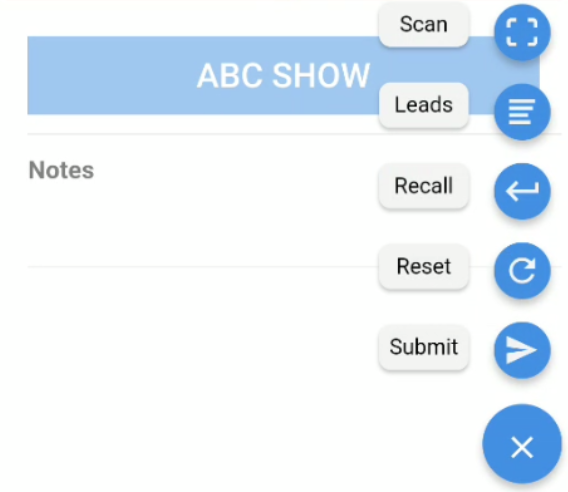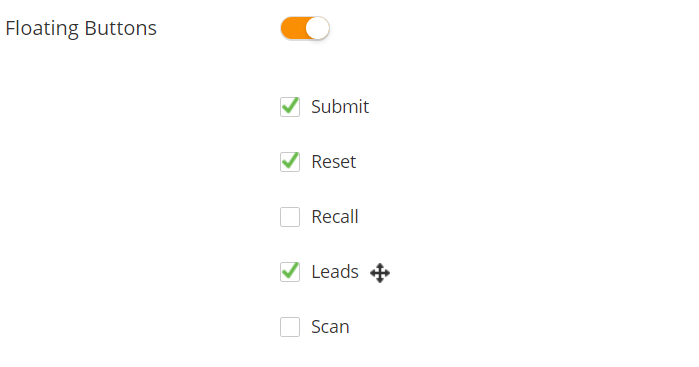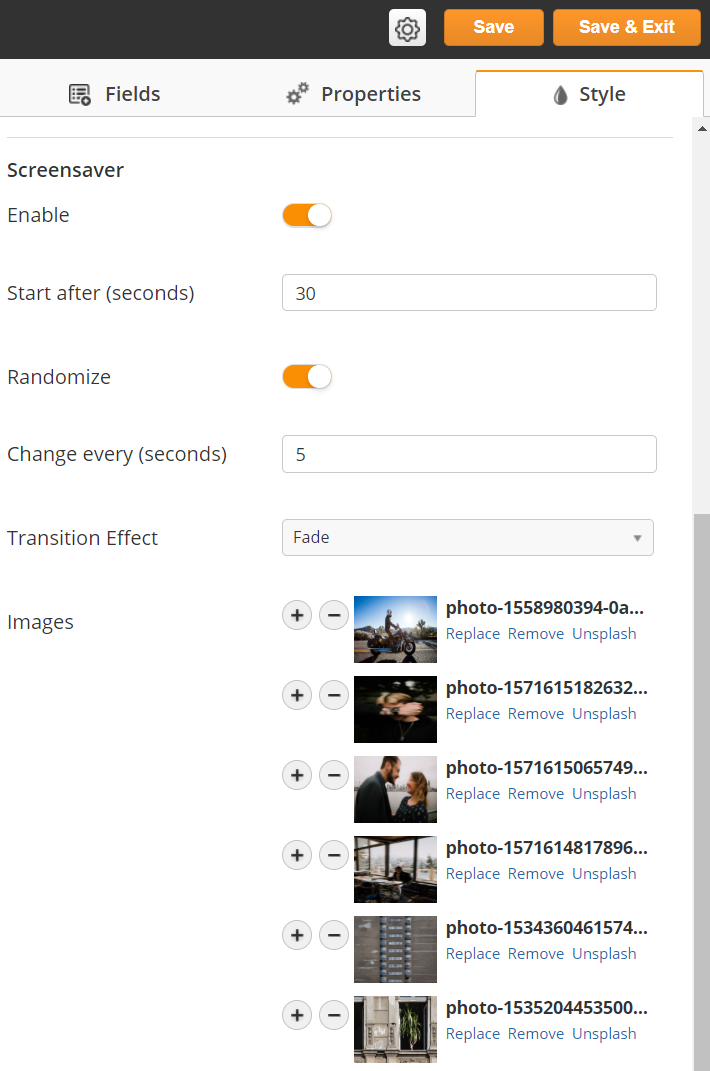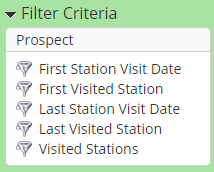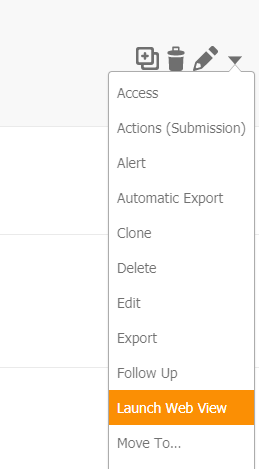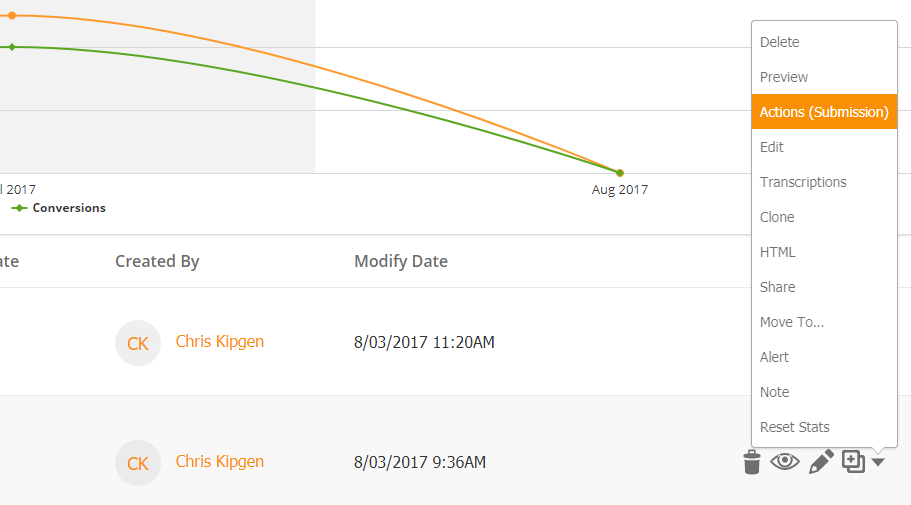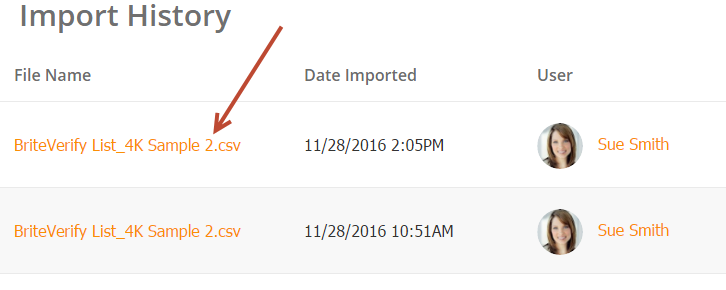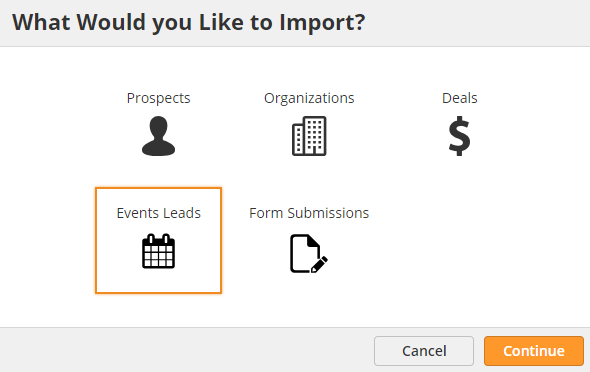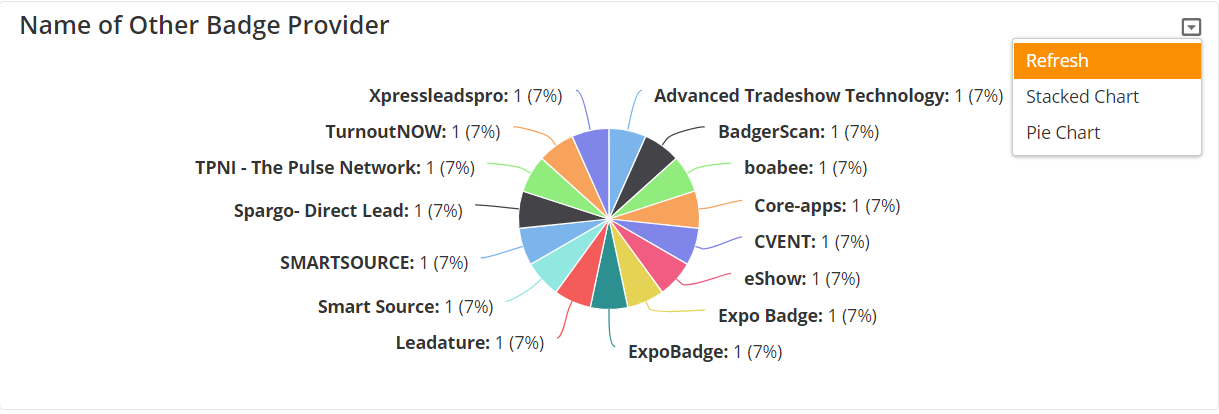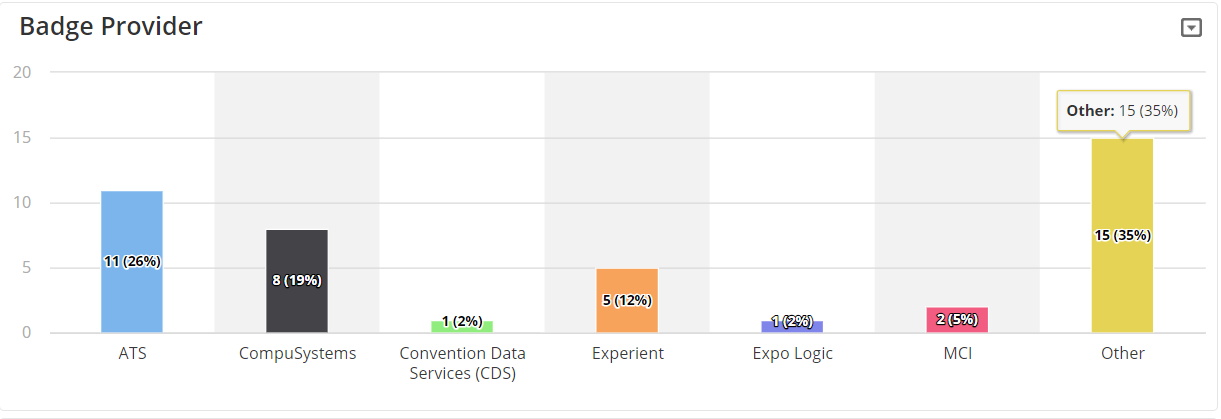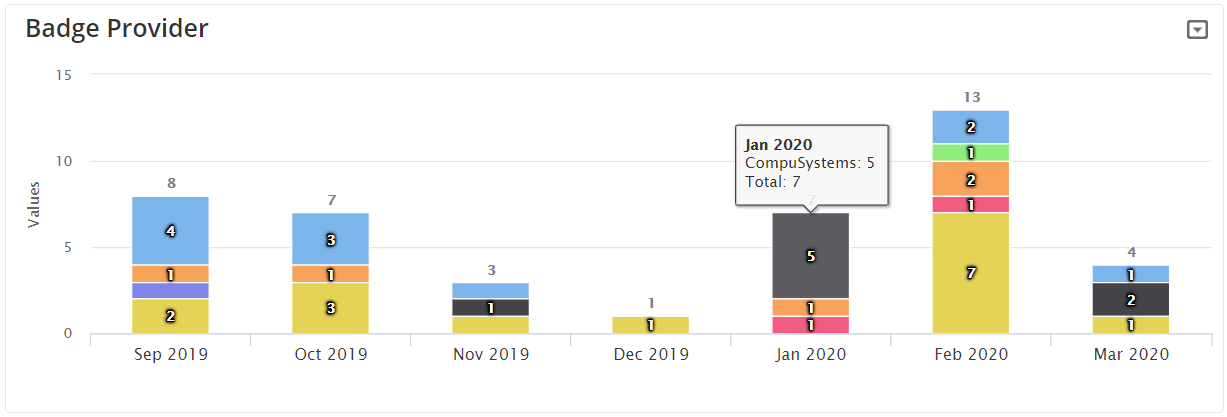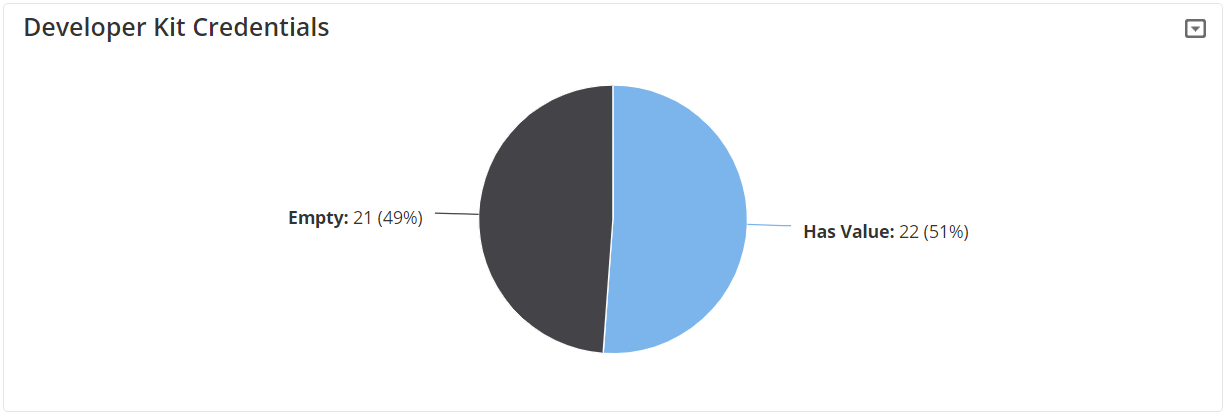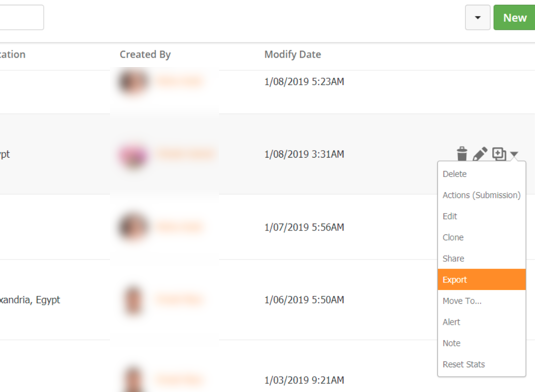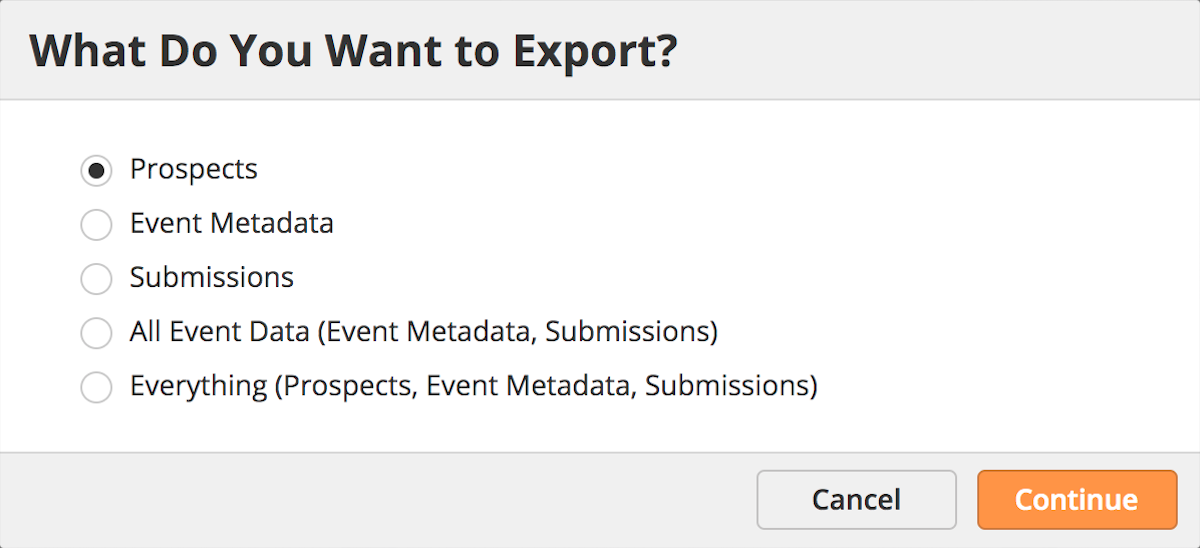Overview
Through fully-customizable forms and business card scanning, the live event lead mobile app makes life easier for sales, while the back office web app give marketing valuable marketing-qualified leads immediately.
Getting Started
Before your team downloads the mobile app, make sure your account is configured right for your Organization.
Security Profiles
Security profiles let you control how much access users have to Lead Capture elements within the Lead Liaison platform. To access security profiles, navigate to Settings > Users > Security Profiles. Click the Edit button to the right of the appropriate profile.
By checking the box next to Lead Capture, you can add or remove all permissions. Press the (+) to the left of the checkbox to view the following individual options:
- Access Event Staff
- Add Elements – add new elements to existing Lead Capture forms.
- Capture Portal – access, complete, or delete incomplete business card transcriptions and barcode captures.
- Change Event Visibility – change the event visibility of the events user has access to
- Create Event Form – create a new form that will appear on devices.
- Create Event Form from Template Only – user must select from a template to create a new event
- Edit Default – edit only the default value of existing elements on an existing form.
- Edit Elements – edit elements on an existing form.
- Edit Events – user can edit events
- Export Submissions – export all the submissions data of the event
- Import Event Leads – mass import new submissions into an existing event.
- Manage All Events – edit or delete any event.
- Manage Assigned Access Events – edit or delete only events assigned to the user.
- Manage Invitation/Devices – add or remove devices from the device list.
- Manage Event Templates – create, edit, or delete templates.
- Manage Groups – create new device groups for form assignment.
- Manage Owned Events (All) – view, edit or delete the events owned by the user
- Manage Owned Events (Private Only) – view, edit or delete ONLY private events owned by the user
- Manage Public/Shared Events – view, edit or delete public and shared events
Notes:
- Events with “Private” visibility can be accessed by any user that have the “Manage All Events“ permission
- Events with “Public” visibility can be access by any user who have the “Manage Public/Shared Events” permission
- Events with “Shared” visibility can be accessed by any user who have the “Manage Public/Shared Events” permission and the event is shared with the user or any assigned team to the user. - Remove Elements – remove exiting elements from existing forms.
- View All Submissions – when using a device, see submissions from other devices.
- View Auth Codes – retrieve authorization codes for device users.
Devices
View, edit, or remove devices by navigating to Event > Capture > Invitations > Devices.
- User– user associated with the device
- Username– username associated with the device
- Groups– number of groups the device is in; click to view
- Type– type of mobile device used
- Date Joined– date the device was activated
- Status– device statuses; Pending (device not authenticated), Active (device authenticated and ready to use), Disabled (device authenticated but disabled in Lead Liaison)
Use the checkbox in the top-left corner to select and delete multiple devices. Use the spyglass symbol to search for devices by name.
Invitations
End users access the mobile app through an invitation. The invitation contains an authentication code the user will user to activate their device.
Individual Invitations
In most cases, you should give each of your attendees their own mobile app Authentication code. You can grant users access either when cloning the templates or after creating the event form.
To give users access when creating a new event:
- Clone the appropriate template.
- Scroll down to Event Access.
- Select the user from the drop-down.
OR
- Click the (+) icon to add a new user.
To give users access to an existing event:
- Click on the Event name to open the Event Designer.
- Click the Properties tab.
- Scroll down to Event Access.
- Select the user from the drop-down.
OR
- Click the (+) icon to add a new user.
Sending New Invitations
There are two types of invitations you can send, Individual and Universal.
- Individual Invitations – Send an authorization code for personal use. This option allows you to identify the individual who has captured the lead and should be your default option. Send Individual invitations through Email, SMS, or both.
- Universal Invitations – Send an authorization code for multiple users to use. This option will not let you identify the individuals capturing leads. This option is best for people who don't normally work with you, like vendors, temp workers, or third parties assisting you at your event. When selecting
Reminders
Reminders help users activate their mobile app. If they have not logged in after a set amount of time, we will send them a reminder email with their Authentication code.
To enable reminders, click on the lightbulb icon next to Event Access. Then, set the number of days prior to the Event Start Date. If the user has not activated by your set date, they will get a follow up email.
Bulk Invitations
You can send Invitations to many users at once using Bulk Invitations. To send a Bulk Invitation
- Navigate to Events > Capture > Invitations
- Use the drop-down menu in the top-right to download the Bulk Invite CSV Template
- Open the spreadsheet and add your user info
- Use the drop-down menu to select Bulk Invitations
- Upload your completed spreadsheet
The Bulk Invite CSV Template includes first name, last name, email, and mobile phone. The system will send an invitation out to their email, phone, or both depending on what your provide.
All four CSV fields must be included or you will get an error. For example, you must include the mobile phone field, even if that column is blank.
After sending your Bulk invitation, you still need to provide your users Event Access. This can be done under the Event Designer properties menu.
Retrieving Authentication Codes
If a user loses their authentication code, admins or other profiles with the right permission can retrieve them. To retrieve the code
- Navigate to Events > Capture > Invitations
- Use the Search icon to find the right user
- Click on the Eye symbol below their name to reveal the code.
Edit a Device
Once a user has activated their device, you can edit their device settings using the action menu on the right in Events > Capture > Invitations > Devices.
Use the trashcan icons to delete the device from your system. Deleting a device will also prevent the user from accessing the mobile app.
Use the pencil to edit the device's name on the device list. This is a helpful option to use if you have multiple users and will be sorting them into groups for various events.
The drop-down menu contains the following options:
- Deactivate/Activate – temporarily remove or add access to the mobile app
- Delete – delete the device
- Edit – edit the device's name
- Groups – manage which groups the device is in
If the user has not activated his or her device, you can edit or resend the invitation from the Invitations tab.
Staff Directory
Staff Directory shows a list of your team members on Captello mobile app who have access to the specific events that you're attending. For live events, this means you can view and communicate with people from your company attending the event.
Every user that has access to the event will be included in the Staff Directory. You can view your staff directory from under the settings gear on event designer page:
You can also change the status of individual staff member to available or unavailable.
In the Captello app, a Staff Directory would display like this:
You can call or text any of the available team members on event. And you can also change your availability status from that page.
Event Groups
Event groups allow you to send forms to select users. For example, if you have a team that is heading to a particular event and have made a custom form for them, you can create a group for that show and add their devices. Only their devices will show the form. To manage device groups, navigate to Settings > Integrations > Groups.
- Name – name of the group
- Devices – number of devices in the group; click to edit
- Date created – date the group was created
- Default – group new devices and forms are assigned to
Use the checkbox in the top-left corner to select and delete multiple groups. Use the spyglass to search for a group by name.
The system will automatically create a new group for every new Event. Likewise, users added to the Event will also automatically be added to the Group.
Edit a Device Group
Edit device groups using the action menu to the right of the group.
Use the trashcan to delete the device group. Use the pencil to edit the name of the group and default toggle.
The drop-down menu contains the following options:
- Devices– add or remove devices from the group
- Forms– add or remove the group from device forms
- Delete - delete the device group
- Edit – edit the name of the group and default toggle.
Localization
You can localize the mobile app for users in non-English speaking countries. Based on their device's language settings, users will see the app in their preferred language when they first authenticate. The app will automatically translate menu options, field labels, and multi-choice options. It will not translate Event Names or Addresses.
The mobile app currently supports:
- English
- Chinese (simplified)
- Dutch
- French
- German
- Japanese
- Spanish
If you need localization in a language you do not see, contact your Lead Liaison representative for more information on adding a language.
To enable localization for app users, navigate to Settings > App Setup > Events and scroll down to Localization. Then select either Auto Translate or Custom Translate.
Auto Translate
Auto Translate uses an advanced translation program to translate English text in real time. With this option, users can easily switch between supported languages. The translations are very accurate, but if your organization uses special words and phrases, the app may not have context to translate properly. In these cases, you should use a Custom Translate template.
Custom Translate
If you want to specify how the app should translate certain internal words or phrases, you can upload a Custom Translate template. To add custom localization support:
- Navigate to Settings > App Setup > Events.
- Scroll down to Localization.
- Select Manage Custom Translate.
- A new page will open showing any current custom translations you may have. Select one of the current ones or click on New for a new translation.
- Set the English word or phrase you want to customize, and the language your changing using the dropdown. Finally enter the translation that is desired.
- Click Save.
Creating an Event
Events are the core of Event Lead Management. They include trade shows, conferences, meetups, and any other live event where you could capture lead data. To set up a new Event, navigate to Events > Capture and click New. Select from the following form types:
- Exhibitor – Used to capture leads at live events or virtual trade shows. Includes all forms of lead capture such as kiosk, badge, and business card.
- General – Used for different types of use cases such as digital marketing, employee engagement, and more.
- Sales – Used by sales teams to capture leads from a mobile device while on the go. Forms never expire and are always available.
Note: the options on the New Capture Form menu will change depending on your form type. Set additional options by clicking the Advanced Settings button.
- Name – name of your Event
- Template – create Event using a Template (see Templates below)
- Save to – save event to a folder
- Campaign – add event to Campaign for ROI tracking purposes
- Description – internal description of event
- Event Date – start and end date of event used for reporting
- Archive Date – the last date end users can capture new Prospects in the mobile app
- Event Owner – user in charge of managing event
- Event Address – physical location of the event using Google Maps
- Registration List – attach a List of attendees
- Labels – custom labels for segmenting reports
- Visibility – Visibility of the event form can be set as Public, Private or Shared
- Event Access – users and groups invited to the event
When providing Users Event access, existing users will appear in a drop down. If the User is not already in the system, you can add a new user by clicking on the (+) button to the right.
Once you click Continue, you will see the Event Designer. From here you can design your Event Form. Customize the form to capture any type of data using the same process as Hosted Forms.
Custom Attributes
Custom attributes are event metadata fields you can add to the New Event menu. For example, you may want to add an attribute for Region which could then be exported with the other event metadata. To manage custom attributes, navigate to Settings > App Setup > Events and scroll down to Custom Attributes.
If you have Custom Attributes, users can select an Attribute to add to Event metadata when creating a new Event.
Device Objects
In addition to the existing web form objects, device forms have several unique objects: Custom Content, Image Capture, Signature, Business Card, Badge Scanner, Audio Recorder, and Documents.
Custom Content
Use Custom Content to add HTML 5 content to your Event Form. You can add text, images, links, and embedded content like YouTube videos or Google Maps. To add Custom Content,
- Add the Custom Content Element
- Optionally re-label the field and select visibility rules
- Click Add Custom Content
- Use the editor to add your content
Image Capture
With the Image Capture element, users can add up to five images to their submission. Drag the Image element to your Event form. The Image element will appear on the device in the same order as the Event Designer preview.
Business Card Capture
Capture Options
Enable transcription. Any submission with a business card attached will go to the
Transcription Portal. The submission will be in "Pending" status until the transcription is complete.
Portal
Choose which transcription service to use.
- Capture Portal – Your company will handle transcribing for no extra charge.
- Expedited Transcription – Cards are transcribed in less than an hour using a proprietary process that includes five human beings combined with advanced business logic to deliver accurate results. Location, time, and day may affect the turn around time of transcriptions. To use this service, you need to add a credit card to your account.
Localization
Select a default language for transcription. When set to English, Lead Liaison will still transcribe foreign languages, but will default to English when possible.
Languages currently supported for transcription are:
- English
- Japanese
- Arabic
- Chinese
- Korean
Specifying a language ensures we default to that language and only use transcribers certified for that language. Localized transcriptions tend to take longer, around 1-3 business days after the end of the event.
If you need transcription in a new language not already listed, please contact our support team at least one week in advance with the following details so we can make necessary arrangements on our end for the transcription:
- Number of leads you expect to capture
- First calendar day and last calendar day where you’ll be collecting leads
- Language you need us to support
Transcription Notes
Add special instructions for our transcribers. For example, you may ask them to use the company name as it appears on the card, not as it appears on the logo. Please note that while we will do our best to follow your special instructions, we may not be able to follow instructions that go outside of the scope of transcribing a business card. For example, our transcribers won't enter a campaign ID or default value into the Notes field. This should be done on the form.
Signature
The Signature element lets end users capture a Prospect's signature. This feature is perfect for opt in statements, non-disclosure agreements, and quotes.
Badge Scanner
Developer Kit Integration
To use badge scanning at your event, you must provide Lead Liaison with the event Developer's Kit at least 30 days in advance. Additionally, if the badge provider only provides a test badge, you must also provide Lead Liaison a production badge at least 24 hours in advance.
To setup up badge scanning on your form, do the following:
- Add the Badge Scanner object into your form:
- Include all fields that you'd like to fill in once a badge is scanned. Typically, these fields are added to the form:
- Name (First/Last)
- Phone
- Address
- Important: You must map your fields to Lead Liaison Standard fields. This tells the system to fill the data into the field. In the example below, we mapped the email field on our form to the Email field in the system. This is done in the settings of each form field under the Map Rules section as shown below:
- To pull all contact information from a badge, there must be field mappings in your form for each of the following system fields:
- Email [Standard]
- First Name [Standard]
- Last Name [Standard]
- Work Phone [Standard]
- Street Address [Standard]
- Street Address 2 [Standard]
- City [Standard]
- State/Province [Standard]
- Zipcode [Standard]
- Country [Standard]
- Job Title [Standard]
Regular Scans (API Kit)
End users can scan Prospect name badges with the Badge Scanner element. Every event is different and will usually have a specific barcode provider. We use a two-step validation process using both the barcode provider's test badge and the show's production (live) badge.
To add the Badge Scanner element,
- Contact the event organizer and purchase an API kit (might also be called a Software Developer's Kit, or SDK)
- Create your Event Form
- Follow the instructions on this page
- Once support confirms they have added the element, test the form
- If the barcode provider only provides a test badge, provide Lead Liaison a production badge at least 24 hours in advance (you will typically get your production badge by mail or during the check in process)
- Once Lead Liaison confirms ready, test the form using your badge
Our system can integrate with any provider that has an API kit. Here are some of the providers we currently integrate with:
ATS BadgerScan Capture Technologies Community Brands CompuLEAD CompuSystems Conexsys Convention Data Services Core-apps Customer Registration Cvent eShow Experient Expo Leads Swoogo | ExpoBadge IDM ITN Leadature Lead Liaison Lead Retrieval MCI Onsite Oxford Tech API Potato Expo SmartSource Trade Show Leads (TSL) vCARD |
Please note that even if you see your show's provider on this list, you still need to follow the process above. API documentation can change from show to show, so it is important you send us everything you receive from the show organizer.
NFC Badges
Some providers use NFC name badges instead of a barcode. In these cases, your device will scan an RFID chip embedded in the badge. Not all devices support NFC scanning, so be sure to check your device prior to your event. Notably, any iPhone prior to the iPhone 7 is not compatible.
Regular Scans (ID Card)
Use the ID option to scan data from North American IDs such as driver's licenses or stats IDs. After adding the Badge Scanner element, select ID as the barcode type and North America as the region.
Make sure to scan the PDF 417 barcode on the rear of the ID. No other barcodes will return data.
Regular Scans (Post-Show Reconciliation)
Some badge providers do not offer an API Developer's Kit and instead offer post-show data merge, also known as post-show reconciliation. Lead Liaison provides full support for this process. The workflow is as follows:
- Scan badges to collect an ID.
- The ID is stored in the Capture Portal.
- IDs are exported from the Capture Portal and sent to the provider.
- The provider sends back a spreadsheet with appended data.
- The spreadsheet is imported into Lead Liaison to complete submissions.
- Any post-submission processes (Fulfillment Actions or Automation) trigger at that point.
Some providers may provide minimal contact data (like name and company) along with the scan. In order to have the best lead capture experience, make sure you send a sample badge through our Badge Scan Request process. Our Events Team can advise what type of process to expect and can configure the form for you. If you choose to configure the badge scanner yourself, we still strongly recommend having the Event Team review it.
Configure your form (no contact data)
To configure your lead capture form for Post-Show Reconciliation, do the following:
- Add the Badge Scanner element to the form.
- Check the Post-Show Reconciliation setting under Rules.
- Select Post-Show Reconciliation under Barcode Provider.
When your users scan, the fields will grey out and display the word Scanned. Users can then submit the form without taking further action. The submissions will appear as Pending until the post-show reconciliation is complete.
Configure your form (contact data)
Some providers will also provide contact data embedded in the badge. This will usually allow you to see Name, Company, and sometimes Job Title. If the provider is also giving contact data, do the following:
- Add the Badge Scanner element to the form.
- Check the Send to Capture Portal setting under Rules.
- Select the appropriate Provider.
When your users scan, the fields with contact data will populate. The other fields will grey out and display the word Scanned. Users can then submit the form without taking further action. The submissions will appear as Pending until the post-show reconciliation is complete.
Submitting Scans
Once your event is over, you'll need to export the IDs from the Capture Portal. Do the following:
- In the Alert Center, select Capture Portal.
- Export your list of IDs by:
- Selecting the Barcode button
- Filtering by your Event
- Selecting Export from options gear
- Run a test scan to ensure badges are scanning properly and the system is pulling in the ID. When your form is configured properly, you'll notice a few things:
- The record will show Post-Show Reconciliation in red font.
- The Barcode ID section will have an ID as the value.
- Once you receive your appended spreadsheet back from the provider import them back into the system to complete the submission.
- Choose Import from the options gear.
- Follow these steps to configure the Importer, as shown below:
- Select your Event
- Select your appended spreadsheet
- Map fields
Import Tips
The fields in the column on the left include standard contact information you'll receive back from your badge provider. The column on the right represents columns from your spreadsheet. The system should automatically map most fields; however, spot check the mapping to ensure accuracy. Imported fields will be saved into the Submission record. This process completes the submission. All standard contact information along with your custom form qualifiers will finalize the submission. Any Fulfillment Actions or Automation actions configured on your event form will trigger at this point.
Post-Show Reconciliation FAQ
- What does post-show reconciliation mean? Post-show data reconciliation (also known as post-show data merge) is a process wherein data is appended to your leads by the lead retrieval provider once an event is over. The process starts when Lead Liaison’s mobile app scans a badge and collects an ID. These IDs are exported from Lead Liaison and provided to the lead retrieval provider. The provider returns a spreadsheet that appends contact information to the IDs. The updated spreadsheet is then imported into Lead Liaison. IDs are matched and leads are submitted at that time.
- What else do I need to ask when I reach out to the event organizer to purchase post-show data merge license? In addition to purchasing the post-show data merge license, ask the provider when they will be able to get a sample badge. Also ask them if there is any data (like the Prospect's name or company) included in the scan for verification purposes, and how quickly the turnaround process will be. The turnaround time will affect your post-capture workflow.
- How does this change my post-capture workflow? Post-capture workflow will not be initiated until data has been collected from the lead retrieval provider and merged into Lead Liaison. Once the data is merged into Lead Liaison, the post-capture workflow will be initiated. Keep this in mind when building your workflow. Immediate follow-up will be delayed until reconciliation has been completed.
- How do I purchase post-show reconciliation? Always opt to purchase the API Developer Kit when available. When it's not available, choose the reconciliation option. For example, the provider below, rainfocus, offers post-show reconciliation as an option (bottom radio button) over using the show-provided scanning app (top radio button).
Rapid Scan
In addition to regular scanning, users can save time with Rapid Scan. With Rapid Scan enabled, users can scan one badge or business card after the next without having to wait for the form to reload. To enable Rapid Scan as an option, turn on the Rapid Scan toggle in the Properties tab of the Event Designer.
Supported Devices
Rapid Scan for business cards is supported on iOS devices only. Android support is coming soon.
Audio Recorder
Use the audio recorder to take audio notes. In addition to recording audio, users can also save time from typing text notes by using Lead Liaison's audio transcription feature.
Audio recordings are saved as a part of the form submission. Users can play the recording from the form or within the submission in Lead Liaison. The system will also save a link to the audio recording saved to the Prospect Profile if the field is mapped. You can map to any paragraph field.
To enable audio transcription, click the Transcribe Audio checkbox on the form element.
Next, choose one of the following transcription types:
- Standard – The recording is run through advanced transcription software. This software is more accurate than most speech to text programs found on mobile devices. Unlike those programs, it is not trying to transcribe in real time, and as a result is significantly better at proper grammar and punctuation. Most transcriptions will take 5-10 minutes, but may take longer depending on the length of the recording. Use this option for single-person recordings and general note taking.
- Premium – The recording is transcribed by a dedicated transcription specialist. Because a human is transcribing the audio, they can ensure the transcription has completely accurate grammar and punctuation. They can also identify multiple people, so this option is great for recording full conversations in addition to longer notes. Use this option for the best accuracy, multi-person conversations, or situations with extreme background noise.
Premium transcription is a paid service billed by the minute. The longer the recording, the higher the cost. Please contact your sales representative for current rates.
The system will save the transcription as a Note in the Prospect's Timeline. You can also save the transcription to a Prospect Field by mapping it in the Update Field drop-down menu.
Schedule Meeting
With the Schedule Meeting option, you can insert a meeting scheduler to the event form for your team to book one on one meetings with the Prospects.
You can also select from the list of available users to schedule the meetings for.
On the event form, users will have the option to select from all available meeting types and book a time on the calendar:
Documents
Use this feature to share documents (or e-literature) during your event. Documents can be previewed and shared outside of the form or selected during form submission and added to an email for follow up. Documents are uploaded to the system and grouped into Document Groups. One or more Document Groups can be included in your event lead capture form.
Supported File Types
Almost all file types are supported. A thumbnail icon is generated for each file type. For PDF files the thumbnail is the first page of the document. For all non-PDF files a generic thumbnail is created. File types that display a thumbnail are:
- .csv
- .xls
- .xlsx
- .doc
- .docx
- .txt
- .mp3
- .mp4
Other file types are supported but may not show a standard thumbnail.
Adding Documents to Your Form
Here's how to setup your documents for an event:
- First, create a Document Group.
- Navigate to Content > Trackable Content > Document Groups.
- Click the New button.
- Click the icon at the top right of the popup.
- A new browser tab will appear. New Documents are added to the system as Trackable Content. Upload all of your Documents. See the tutorial on Trackable Content for more info.
- Return to the original tab with the Documents popup and click the reload icon to see the documents you just uploaded.
- Follow the steps below to save your Document Group. The numbers below correspond to the numbers in the screenshot below.
- Search for Documents by name.
- Click the plus icon to add more Documents.
- Click the reload icon to see newly added Documents.
- Check the box next to the Documents you want to include in your Document Group.
- Enter a name for your Document Group. Important: This is the name that will appear on the button label in your lead capture form.
- Click Save.
If you're not sure of the name of your Document, you can also browse in thumbnail view by clicking the tile icon in the top-right corner.
- Once your Document Group is setup, return to your event form by navigating to Events > Capture.
- Add the Documents object into your form by dragging/dropping it from right to left.
Adding More than One Document Group
More than one Document Group may be added to your form. When using the Document menu option on the mobile device, the list of Documents will be shown right away when there's only one Document Group in your form. When there's more than one Document Group, the user will need to select the Document Group to select Documents from within that Document Group.
- Click on the Document object on the left to open the settings panel on the right.
- Field Label: This label will not be used in the lead capture form on your mobile device. It’s intended to be used in the form builder to help you separate multiple Document Groups.
- Document Group: Select the Document Group to be associated with your button. When a user taps on this button they will see all of the Documents within this Group.
- Click the icon to add another Document Group to the dropdown list.
- Click the icon to edit the Document Group selected from the dropdown.
Including Documents in Follow Up Emails
To include Documents in your email when following up with your leads do the following:
- Navigate to your email by going to Content > Emails.
- In the email builder, click the Fields button:
- Select Document Group from the Category option.
- Select your Document Group from the Field option.
- The system will insert dynamic content into your email with a bullet point as shown inside the red box below. Only selected Documents will be included in the bullet list inside your email.
- On the recipient's side, they will see links to their Documents as shown below:
- Here's a sample follow up message. When Documents are included, there will be a perfect amount of spacing between the paragraphs and signature with each Document link preceded by a bullet list item. If no Documents are included, the Document section will not appear in the email.
Example Follow Up
Thank you for stopping by our booth at ___! I hope you had a safe trip back from Miami, FL. Please reply to this email if you have any questions about our solution.
- {% for document in ___documents_set.YpqGReWCKUpOAIhaX___ %}
- {{ document.name }} {% endfor %}
- All links are trackable. Every time a Document is downloaded the system will measure engagement. To see your Document statistics navigate to Content > Trackable Content.
- Total and Unique Downloads are recorded. Click on the Unique Downloads stat (inside the red box below) to see who downloaded your Documents!
Using Documents on Your Mobile Device
Mobile app users can use your Documents to:
- Share Documents from the Event Menu.
- Select Documents to include in follow up.
Video Tutorial
Tip: Long press on a Document thumbnail to open the Document.
Sharing Documents
To share Documents do the following:
- Tap on the event to open the Event Menu.
- Select Documents.
- If more than one Document Group exists then the user will need to tap on the relevant button first. If only one Document Group exists then skip to the next screen below.
- Tap on the Documents to share. A green check will appear at the bottom right of the Document thumbnail indicating it's been selected.
- Click the Send button.
- Choose your share method. The following sharing methods are supported:
- Email: Opens the device's native email client and inserts trackable links for your Document(s).
- SMS: Opens the device's native SMS client and inserts trackable links for your Document(s).
- WhatsApp: Opens WhatsApp and inserts trackable links for your Document(s).
Selecting Documents for Follow Up
To share Documents for follow up in an email do the following:
- Open your Event form on your mobile device.
- Capture lead information on your device as your normally would.
- Tap the button for the Document(s) you'd like to include in your follow up. In the example below, two buttons (a.k.a. Document Groups) are added to the form.
- Tap on the Document(s) to select them. A green check mark will appear for all selected Documents.
- Click the Done button.
Sections
Organize your lead capture forms using Sections. Sections group together common fields like contact data, company info, or survey questions. With Sections, your form is cleaner and easier to manage for end users. To add a Section
- Drag over the Section element
- Drag fields into the section
- Click the section header to edit
- Give the section a name
- Select whether the Section should be open or collapsed by default
- Optionally add visibility rules
On the app, users can tap on sections to show/hide their fields. See the screenshot below. The Contact Data Section is expanded while the Company Info Section is collapsed.
Form Styling
You can add custom styling to event capture forms to match your branding and provide and exciting end user experience. To change your style options, open the Event Designer and Click on the Style Tab.
#1 and #2: Cover Images and Cover Fonts
Cover images make your events easier to distinguish and add a bit of flare. You can select your own custom cover image, or click the Unsplash icon to select from thousands of images in Unsplash's library. Otherwise, the system will use one of 10 stock images.
Custom Images
Use an aspect ratio of 1.75 width x 1 height for custom images.
You can adjust the font color of the Event name and address by clicking on the box next to Font Color. You can either use our color selector or enter a specific hex code.
#3: Form Label Color
The color of all of the fields / questions on your form can be changed using this setting. You can change the font color of the form labels. Form labels include the Field Labels as well as Field Sub Labels (for example, First and Last under the Name field). You can either use our color selector or enter a specific hex code.
#4 and #5: Form Background Color and Form Background Image
Change the color of the form's background or add a background image.
#6: Field Background
If you're using a background image on your form you might benefit from using the Field Background setting. This setting adds a background behind each question / field label.
Max Width
This determines the maximum width of the event form in Web View. Turning this option ON will do the followings:
Set a max-width to the capture form container
Make it centered
If the form has a background, make the background on the entire page, not just the capture form.
Document and Section Background Color
The buttons generated for Documents and Sections inherit your themes color. However, you can override the theme color by clicking on the Document or Section on the canvas, clicking the Style tab, and toggling the switch to change the button background color and font.
Menu Color
By default, the mobile app menus are orange. You can change the color of the app's menus from Settings > App Setup > Events.
If you would like to add a custom color, please contact your Lead Liaison representative. Include the exact HEX code for the color you would like to use.
If you are already logged into the mobile app when you change the color, you will need to unauthenticate and re-authenticate your device to see the color changes.
Menu Options
You can choose from two different menu options: the Buttons Menu and Floating Buttons. The menus to be configured per event, so customize them to fit the capture style of the associates attending your event.
Buttons Menu
The Buttons Menu is a horizontal menu at the bottom of the form.
Use the checkbox to select/deselect which buttons you would like present on the Buttons menu. Use the cross arrow to the right of the buttons to rearrange them.
- Submit – submit current submission
- Reset – clear all form fields, scans, images, and recordings
- Recall – retrieve the last submission for editing
- Leads – takes user to the Review Submissions page
- Scan – scan a name badge or business card (depending on if those elements are on the form
If your form is in Kiosk Mode, the only buttons available will be Submit and Reset.
Floating Buttons
The Floating Buttons are an alternative menu style to the Buttons Menu. Instead of displaying across the bottom of the form, the buttons can be shown/hidden by tapping an icon.
Use the checkbox to select/deselect which buttons you would like present on the Buttons menu. Use the cross arrow to the right of the buttons to rearrange them.
- Submit – submit current submission
- Reset – clear all form fields, scans, images, and recordings
- Recall – retrieve the last submission for editing
- Leads – takes user to the Review Submissions page
- Scan – scan a name badge or business card (depending on if those elements are on the form
If your form is in Kiosk Mode, the only buttons available will be Submit and Reset.
Screensavers
Screensavers are a great way to display advertising and other exciting graphics on kiosk forms. To add a screensaver, click on the Style tab in the Event Designer and scroll down.
- Enable – turn on/off the screensaver on this form.
- Start after – time in seconds before the screensaver activates.
- Randomize – randomize the selected images.
- Change every – time in seconds each image displays.
- Transition effect – effect while changing images.
Images – select your own images or select from Unsplash; use the +/- buttons to add or remove images.
Once you close the form using the Save and Exit button, the updated screensaver will be pushed to all devices.
Stations
If you are capturing data at multiple locations in an event, use Stations to report where your leads are coming from. For example, you could see which leads you captured at your booth versus which you captured at your networking party. The system will roll up Prospects from the stations into a single event report, so you don't have to manually combine the data after the event.
To add stations,
- Click on the Settings gear in the top-right corner of the Event Designer
- Click Stations
- Enter Station names
- Use (+) or (-) to add/remove stations
- Click Save
When exporting Event Metadata, the following options are available when using stations:
- First Visited Station
- Last Visited Station
- First Station Visit Date
- Last Station Visit Date
- Visited Stations
You can use these fields in Automations, Segmentations, and Prospect Filters as well.
Visibility
You can set the “Visibility” of the event form as:
- Public
- Private
- Shared
When "Shared" is selected, you can specify the users and teams to share the event form with:
On the Manage Events pages, these badges are displayed to show the visibility status of an event form:
Web View
You can launch a Web View of your Event Forms for use in virtual events or PC-based kiosks. To launch the Web View, use the action menu to the right of the Event to select Launch Web View.
The form will launch in a new browser window. Copy the URL of that tab to share a link or embed.
There are a few options you can configure for the Web View. To view the options, edit the Event and go to Properties > Web View.
You can set if the Event form should attempt to collect and record someone's location using Collect Location option
You can also set what happens when the form is submitted.
- Start over – reloads the form; good for kiosks and terminals.
- Thank you message – displays text confirming submission.
- Redirect to a Link – redirects browser window to specified link.
Field visibility
Every field you have added to the form can be configured for if it is visible on Web view, Mobile view or both
Duplicates
Lead Liaison normally merges duplicate prospects into one profile. However, lead capture forms can create prospect profiles by name only. If you want to create a new profile for every submission, navigate to the Properties tab in the form builder and select "Create new" under "In case of duplicate names."
If you do capture an email address, the system will use the email as the prospect's unique identifier instead of the name. You can control the behavior of the system when this is the case.
- Accept - the system will create a duplicate submission for the same Prospect. This could result in a different number of total submissions vs total unique Prospects.
- Reject - the system will reject the duplicate, leaving the submission Blocked on the user's device.
- Edit - the app will open the previous submission and give the user the option to edit.
- Merge - the system will merge duplicate submissions with the first submission. Click settings to determine field-level settings (overwrite, ignore, update if empty.)
Block Submissions
This option allows you to block submissions from domains and emails. When this option is enabled, you can block submission using the following options:
- Domain List(s) - Pick from a predefined domain list.
- Enter domain(s) - Manually enter the domains to block e.g. gmail.com, hotmail.com.
- Enter email(s) - Enter email addresses to block submissions from.
There are two methods of blocking:
- Mobile device submissions - When enabled, you can specify a message to show when the submission is blocked. Default is "Form not submitted."
- Web view submissions - When enabled, system will not accept web view submissions. With this option, you can either show an error message or you can add a redirect URL. If you choose a Redirect to URL then you can also specify whether you'd like to record the submission in the backend. This is controlled by enabling or disabling the "Accept submissions" option.
Note: If Block Submissions is turned ON then you cannot save the event form unless at least one of the above blocking methods is enabled.
Personal Email Addresses
You can block personal email addresses. For example, you may not want to process leads who have a yahoo.com or gmail.com email address. You can also use this function to block specific email domains (a competitor's email domain, for example). To block personal email domains,
- Set up your Personal Email Domain List (learn how here).
- Navigate to your Event Form's Settings menu.
- Click the box shown in the screenshot below.
If a user tries to submit the Form with a domain on your Personal Email Domain List, they will see an error and be unable to complete the form. You can customize the error message using the box that appears below the "No Personal Email Addresses" checkbox. Note: it will only appear when the box is checked.
Owner
By default, when a device user submits a prospect from a lead capture form, the system will assign the user as the prospect's owner. You can change this setting in the form builder under the Properties tab.
- Device user – system assigns prospects to the user associated with the submitting device
- Specific user – system assigns prospects to a specific user of your choosing
- Leave Unassigned – does not assign an Owner and relies on any default settings
- Default owner – system assigns prospects to the global default (must be set in Lead Distribution Settings as shown in the screenshot below)
If you would like the system to override any current lead owners in the system in favor of your form settings, simply click the checkbox on the bottom.
Quick Capture Mode
When your Event is in Quick Capture Mode, the Event Form will reload after the end user hits Submit. This mode is perfect for high-traffic events.
Kiosk Mode
If you plan on setting up a form that event attendees will set up on their own, use kiosk mode. Kiosk mode locks the app so users cannot back out of the form without a passcode. When an attendee submits the form, the form will reload for the next attendee.
To enable kiosk mode, enter the form builder and click on the Properties tab. Check the "Enable kiosk mode" box.
While kiosk mode will lock the mobile app, it will not prevent users from accessing your device. We strongly recommend you lock the device software on the app. At a minimum, iOS users should set their device into Guided Access mode (https://support.apple.com/en-us/HT202612). While Android users can pin their app for some security (https://support.google.com/nexus/answer/6118421?hl=en), its effectiveness may vary from device to device. You should consider using an approved third-party kiosk app from the Google Play store.
In addition to configuring your device for kiosk mode, make sure you also lock down your physical device. We recommend using something that limits access to the device's home and power buttons at a minimum. Make sure it has a physical lock connecting it to a stand or table that someone would not be able to easily take without notice.
Edit or Delete a Form
Editing and deleting a device form is the exact same process as editing or deleting a web form. From the Events menu, use the trashcan and pencil icons to the right of the appropriate form. If you edit a form, device owners will receive a push notification letting them know a form has been updated. If you delete a form, the form and its submissions will be removed from their device.
Templates
Templates make it much easier to create new Event forms. They also help make sure you have a consistent experience across all events, while also reducing human error with event coordinators who may not be as familiar with the process.
To create a new Template,
- Navigate to Events > Capture.
- Click on the Templates tab.
- Click New.
- Follow the instructions above for creating a new Event Form.
- Click Save and Exit.
If you give users Event Access on the Template, they will have access to every Event Form created from this Template. Only add users like event coordinators who should see every Form created from this Template on their device.
Unlike an Event Form, Templates will not appear on user's devices. Instead, when creating a new Event, select the Template from the Template drop-down menu. This will create a new form using the exact settings you used with the Template. Users can then Save and Exit to send out the new Event Form, or they can modify the new Event Form to better match their show.
You can control how much users can edit forms created from Templates. First, you can control who can add, edit, or delete fields using the Security Profile settings described above in this document. Second, you can set field permissions in the template itself. See below.
- Edit – if unchecked, users cannot edit this field on Forms created from this Template, even if they have the appropriate Security Profile settings.
- Delete – if unchecked, users cannot delete this field on Forms created from this Template, even if they have the appropriate Security Profile settings.
Once you've completed the Template, you can add a Fulfillment Action to it. The Fulfillment Action will apply to every Event created from the template. See below for more on Fulfillment Actions.
Fulfillment Actions
You can add a fulfillment action to any device form. Fulfillment actions are one-step, instant automatic actions performed the moment a form submission comes in. You might add a tag with the event's name to the prospect profile, send the prospect to a deeper nurture automation, or use a webhook to send a text message thanking the attendee for their time.
To add a fulfillment action, use the drop-down menu in the action menu to the right of the form. Click on Actions (Submission).
In the Fulfillment Action pop-up window, use the drop down menu to select your desired action.
Toggle whether an action is repeatable using the green circular arrows to the left. Use the (+) icon to add additional actions. Remember, all actions will happen instantly.
To lean more about using fulfillment actions, click here.
Importing a Pre-event List
You can import a list to easily pull up contact information at your event. If your event organizer provides a list beforehand, follow these instructions to connect the List to your form.
To import a list from a CSV, XLS or .XLSX file do the following:
- Prepare your file for import. For a contact to be imported, the contact must have at least an email address or full name. If an email address is not provided then we check for a Full Name (or First Name and Last Name). If a Prospect is found with the same name then the import record is matched with the first contact the system finds. If no match is found then a new Prospect record will get created.
- Optionally create a List. Note, it's not mandatory to import contacts into a list. They can be directly imported into the system.
- Click Prospects > Import
OR - Click Sales > Import and select Prospects if you are using OneFocus™ CRM
- Drag & Drop the file into the dashed border box or select your file using the Upload button
- Map fields. Most fields are automatically mapped; however, check all your fields to ensure the data is mapped to a Lead Liaison field.
- Import options per field:
- For Multi-Picklist Values:
- Ignore: Ignores the imported field data.
- Overwrite: Overwrites the data in the list and Prospect data if the imported data is not empty.
- Merge: Applies only to multi-picklist fields. Imported data will be used to update a Prospect's info without deleting existing information. For example, if the field is "Favorite Colors" and the Prospect's field has "Red, Blue and Green" and the imported data is "Brown, Green", then the resulting field data will be "Red, Blue, Green and Brown". Use a semicolon (; to separate multiple fields on your imported data.
- For Everything Else:
- Ignore: Ignores the imported field data.
- Overwrite: Overwrites the data in the list and Prospect data if the imported data is not empty.
- Update if empty: Overwrites the data in the list and Prospect data if the imported data is not empty and the Prospect's existing field data is empty.
- For Multi-Picklist Values:
- Preview results. The first ten rows of data will be shown in the preview.
- Set your import options. Lead Liaison provides several options to add Prospects to a list, tag them, assign ownership, assign to a Campaign, set a Lead Source, and more. You must import your Contacts into a List to attach them to a GoCapture!™ form. Each option is explained below:
- Add to Lists(s). Select which list(s) to import contacts into. Note, this step is optional. Click the Create New List link to create a new list on the fly.
- Add Tags. Assign one or more tags to your imported Prospects. Click the Create New Tag link to create a new tag on the fly. To learn more about Tags read this.
- Assign Owner. Select which Owner to be assigned to all imported contacts. See Setting Lead Owner section below to assign individual Ownership within the import file. Assigning ownership within the file overrides the Owner: settings as shown in the screenshot above. Select Unassigned from the Owner drop down to not assign an Owner to each contact. The default Owner will be the user who is conducting the import.
- Assign to Campaign. Assigns imported Prospects to a Lead Liaison Campaign. To learn more about Campaigns click here. To create a new Campaign click the plus icon to the right of the drop down.
- Set Lead Source. Assigns a value to the Original Lead Source field. If the Prospect already exists you can override the Original Lead Source value by enabling the Override Existing Lead Source toggle switch. To create a new Lead Source, click the plus icon to the right of the drop down.
In order to connect the List to a GoCapture!™ form, you must import your Contacts into a List.
- Click Next.
- Click Run.
- View Results, Go Home, or import another file.
Download Past Import Files
To download files that have been previously imported do the following:
- Navigate to Prospects > Import
- Click the name of the file under the File Name column as shown below
Viewing Imported Prospects
To view prospects from previous imports do the following:
- Navigate to Prospects > Import
- Select Results under the actions column as shown below
Setting Lead Owner
Add a "Lead Owner" field to your import CSV file to automatically set (or overwrite) the existing lead owner value in Lead Liaison.
Use Lead Liaison Username
Please note the value of the Lead Owner must be the Lead Liaison username of the Lead Owner. The Lead Liaison username is the username used when logging into Lead Liaison. To see your teams usernames look under the "User Name" column on the Managing Users page.
Importing Names
When importing names the First Name and Last Name must be separated into two distinct columns. Here are simple instructions on how to split names using Microsoft Excel.
Importing Boolean Fields
When importing a boolean field (1 or 0, true or false, yes or no) the following values are accepted:
- "true" or "false" (not case sensitive)
- "yes" or "no" (not case sensitive)
- "0" or "1"
Using 0
When using "0", the imported value will be empty. If you want the imported value to show up as "No" use "false" or "no".
These Lead Liaison Standard Fields are examples of fields that accept boolean values:
- Do Not Email
- Do Not Call
- Bounced
Importing Submissions
In some cases, you may need to import form submission data. For example, one of your representatives may have taken down a Prospect's information on a paper form rather than using the mobile app.
Managing Transcription Fees
- If you're importing into an event that had the transcription feature turned on, then make sure your import file does not have a "Business Card" column and is not mapped to the "Business Card" field. As long as that is the case, then a transcription request will not be triggered.
- If you're merging a record with an existing record in the same event that was already transcribed, then you will not be charged as the record will only be updated.
To import submissions,
- Navigate to Settings > Import
OR - Navigate to Prospects > Import if you are not using OneFocus™ CRM
- Select Event Leads
- Select the Event the submissions are from
- Choose whether to merge or create duplicate records
- Drag your spreadsheet into the uploader
OR - Click the Upload button and select your file
- Map spreadsheet fields to the event form fields
- Check the preview for accurate mapping
- Select additional options, such as adding to a List or a Campaign (learn more here)
The system will treat these imports like they are real-time Event submissions. This means Automations and Fulfillment Actions tied to these Events will trigger.
Question Stats
You can use Question Stats to see aggregate response data. For example, you could review which of your products were of the most interest. To view question stats
- Navigate to Events > Capture
- Use the drop-down menu on the right to select Question Stats
- Select a date range
Most fields will have different reports available. You can use the toggle in the upper-right corner of the field to change the report type.
The following reports are available:
- Range Analysis: all responses in a Single-Line Text field by percentage.
- Column Chart: all responses in a multi-select field by percentage.
- Stacked Chart: responses by date and percentage for multi-select field. Note: this will only show empty/has value for text-entry fields.
- Pie Chart: percentage of response vs. no response for text-entry fields.
Exporting Data
Lead Liaison can export event data to third party systems. To export event data,
- Navigate to Events > Capture
- Locate the appropriate Event
- Access the drop-down menu to the right
- Select Export
You can choose to export the data below. The last two options have groupings of the first three options to make it easier to export.
- Prospects: Any Prospect data from standard and custom fields. Data captured in your Event form can be mapped to Prospect fields. While Event submission data is valid for your Event, Prospect data persists through your use of the platform.
- Event Metadata: Event metadata includes the event name, date, location, owner, user capturing the data, and labels.
- Submissions: All data captured from a lead via your Event form.
- All Event Data: Includes Event Metadata and Submissions data.
- Everything: Includes Prospects, Event Metadata, and Submissions data.
Once you have selected the type of data to export, continue to export following the instructions located here.
In the video below, we walk you through the export experience and how to choose Prospect data:
